Australian
and international
exploratory
performance and
media arts
Once again Performance Space’s Liveworks Festival of Experimental Art has produced a program of small scale performances of often visceral intensity and formula-testing inventiveness, including works from Taiwan, Japan and Indonesia. We felt honoured to be part of this year’s festival with RealTime in real time (image above), a five-hour conversation about art in the 25 years of the magazine’s publication. Also in this edition, Zszusanna Soboslay adds a second instalment of her reflections on writing for the magazine across those many years and Philip Brophy looks at motivation and writing practice in the production of his revered Cinesonic series (1997-2001) for RealTime. Urszula Dawkins singles out a fascinating preoccupation with place among some of the 40 articles she wrote for us and Katerina Sakkas provides an insightful overview of her responses to horror films, especially those made in Australia and empowering women filmmakers. Finally, we’ve issued another batch of Writers read RealTime, in which intriguing correspondences between reviewers’ voices and writing styles are revealed. Good reading and listening, Virginia and Keith
–
Top image credit: L to R: Jonathan Marshall, Rachel Fensham, Philipa Rothfield, Greg Hooper, Andrew Fuhrmann. Background: Karen Pearlman, RealTime in real time, Session 1.
As part of Performance Space’s Liveworks, RealTime writers from around Australia gathered with artists and readers to consider the enormous changes in the arts 1994 to the present in an informal five-hour conversation that variously free-floated, hit home and entertained. We’ll soon publish a distillation of the audio-recording, including the words from some very funny performances about performance. In the meantime there’s a selection below from the photographic record of the event with more to come.
RealTime in real time was a wonderful coming together of people who had rarely or never met face to face over 25 years, who’d read each other’s writing to learn what was happening from northern Queensland to Hobart and from Sydney to Perth and many places in between. The event quickly became as much a celebration of RealTime as of the art the magazine had critiqued and supported.
Our thanks go to Heidrun Löhr (Sydney’s beloved photographer of all things performative was interviewed as part of RealTime in real time) for the images and Performance Space for commissioning them. Thanks also to the Guardians of RealTime committee for their support for the event, to Caroline Wake, who presented the third of the event’s sessions and to Gail Priest for the theme ‘tune’ and technical know-how. And a big thanks to Jeff Khan, Artistic Director of Performance Space, for including RealTime in real time in the 2018 Liveworks Festival of Experimental Art program.
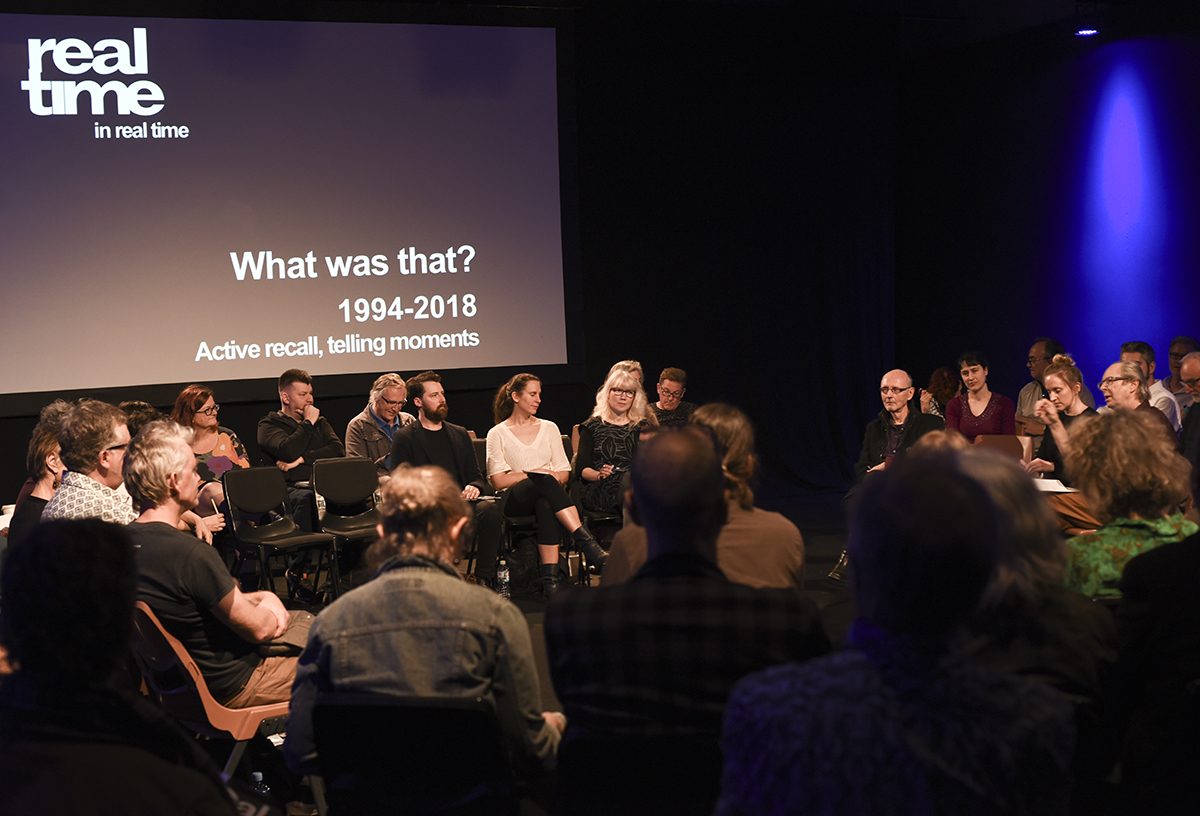
Session 1, RealTime in real time, Keith Gallasch (R) facilitates discussion, photo Heidrun Löhr
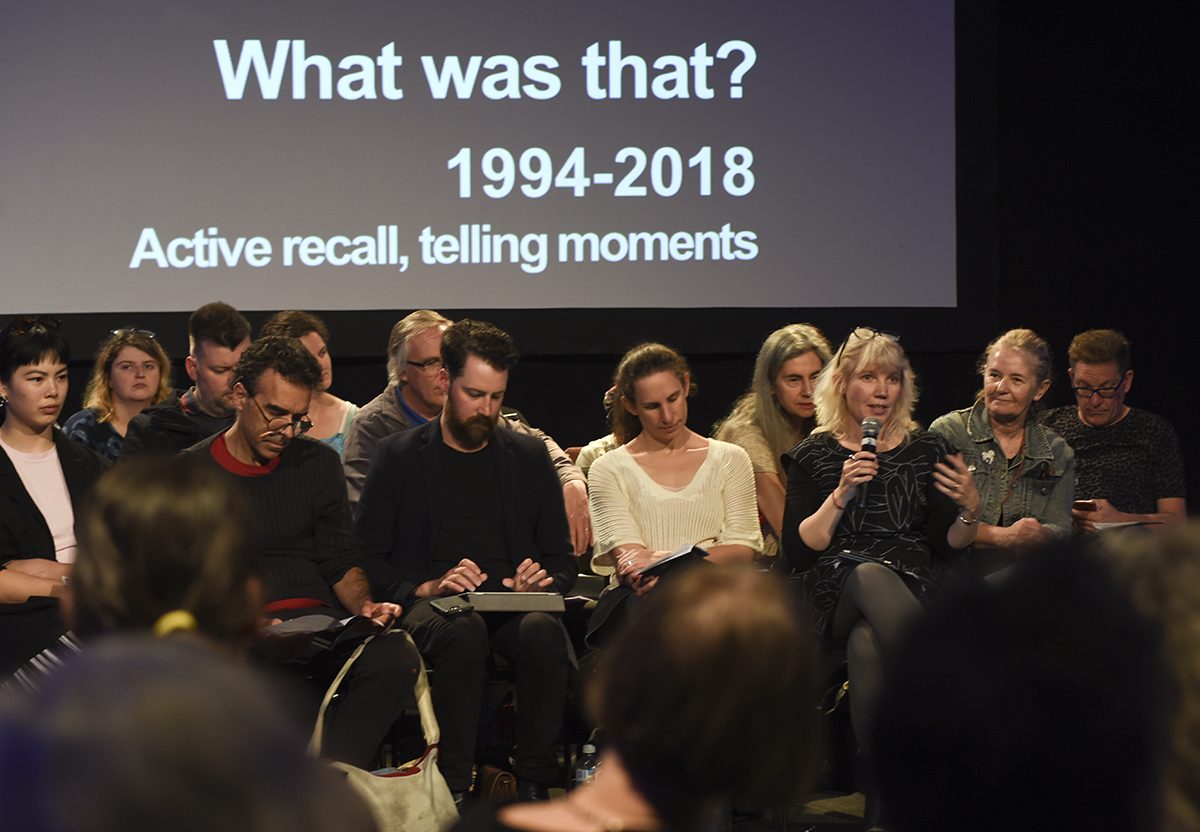
L-R: Richard Allen, Mathew Lorenzon, Felicity Clark, Gail Priest, Kate Richards, RealTime in real time, photo Heidrun Löhr
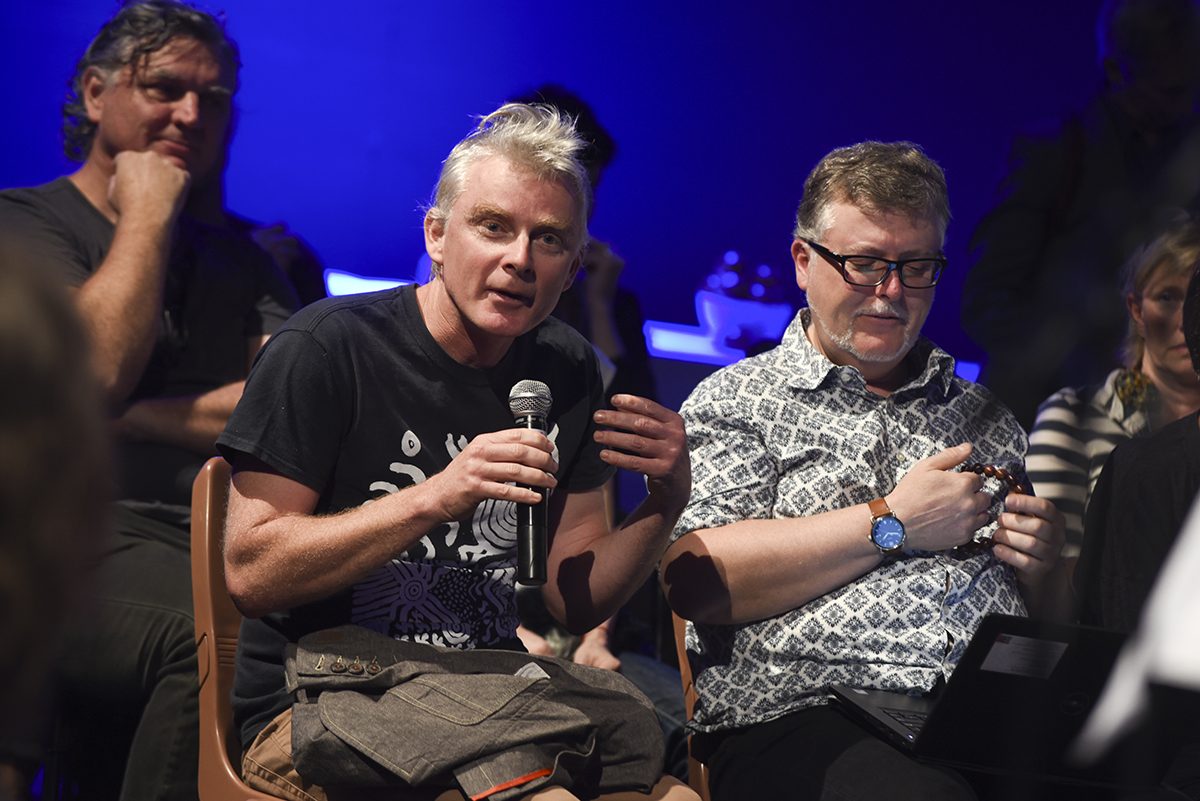
L-R: Russell Milledge, Darren Jorgensen, Jonathan Marshall, photo Heidrun Löhr
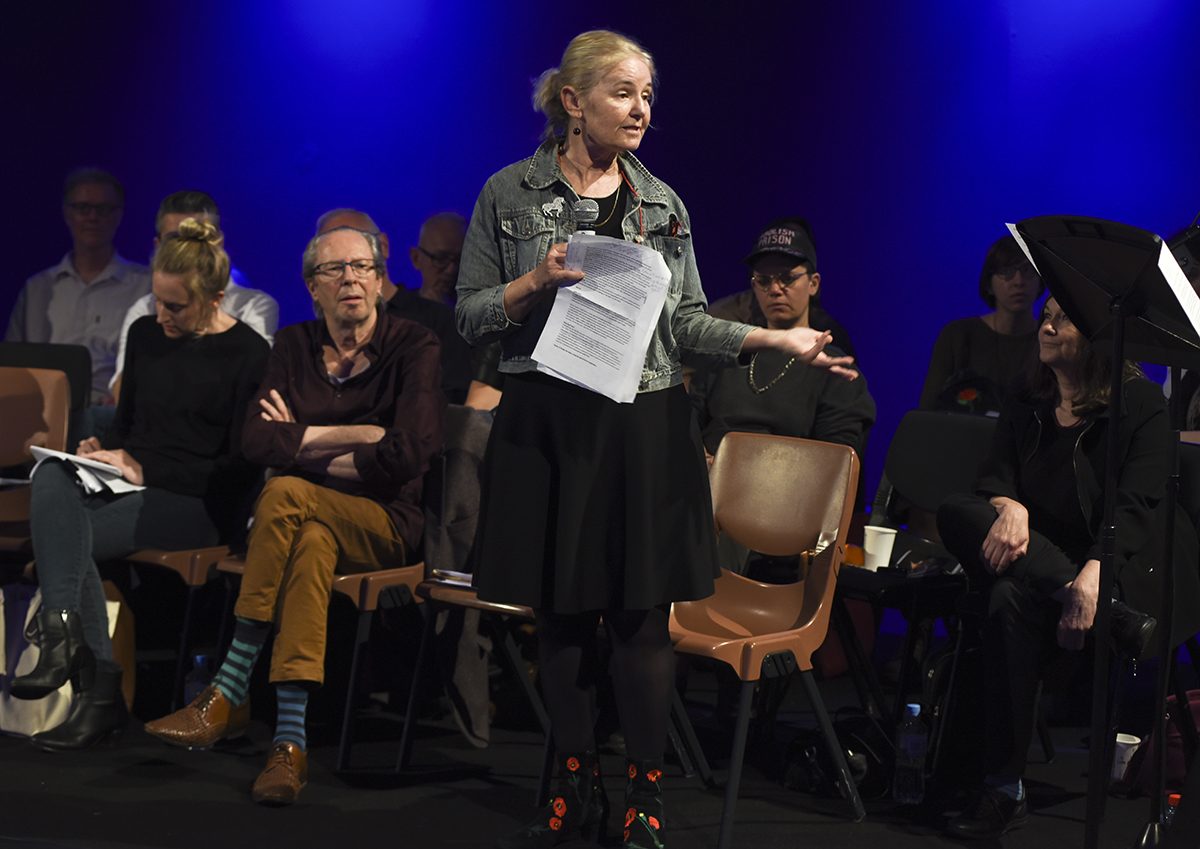
L-R: Caroline Wake, Keith Gallasch, Kate Richards, RealTime in real Time, photo Heidrun Löhr
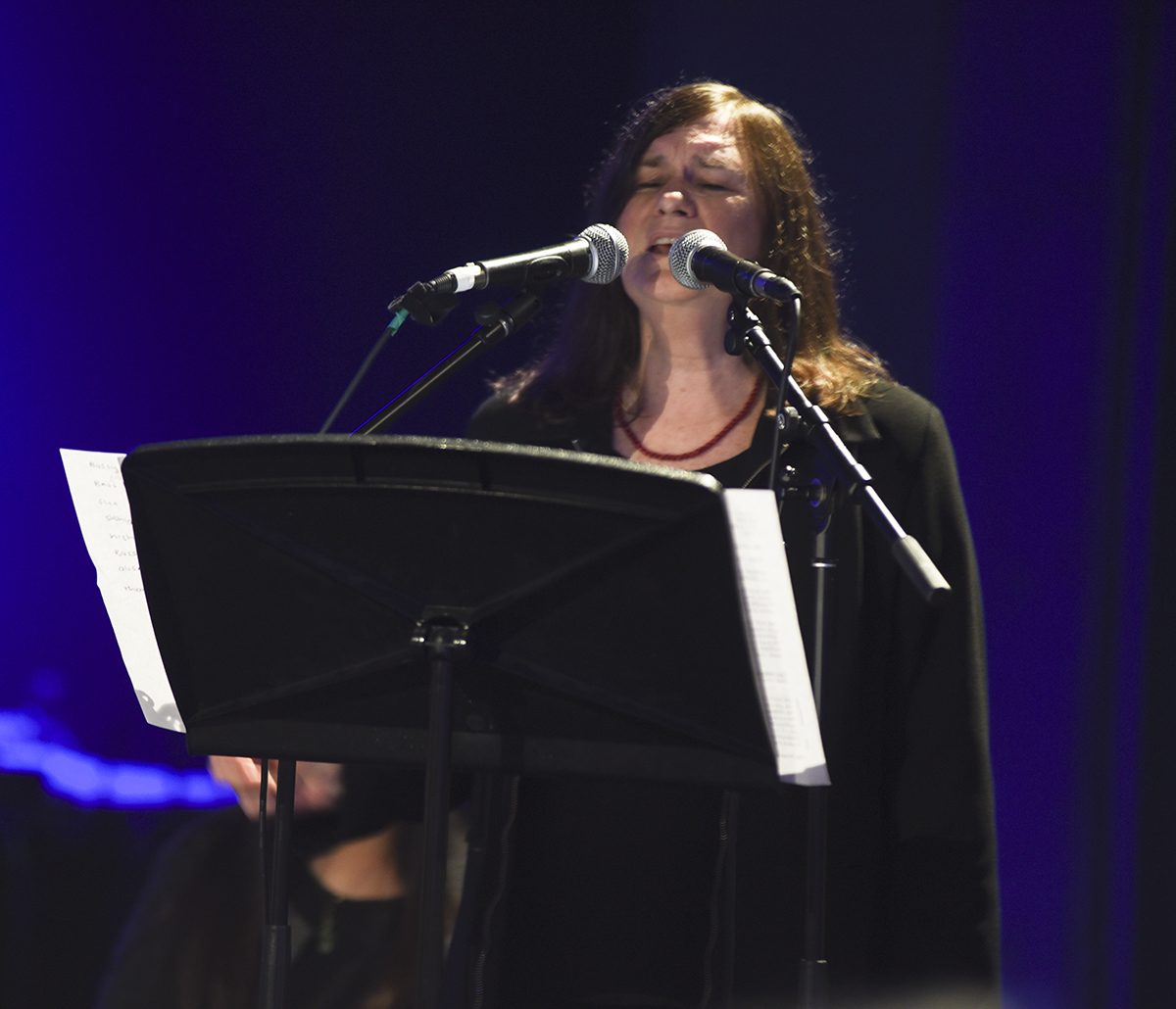
Amanda Stewart, RealTime in real time, photo Heidrun Löhr
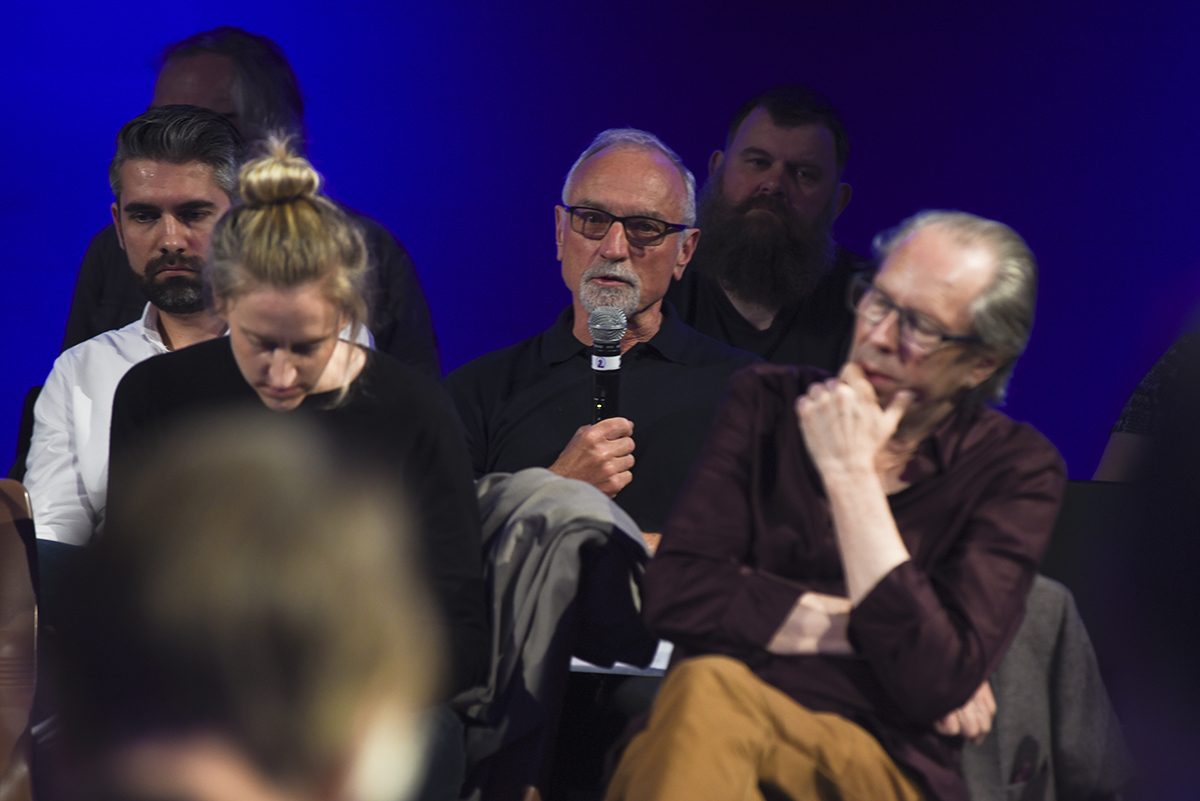
L-R: Ben Brooker, Caroline Wake, Chris Reid, Andrew Harper, Keith Gallasch, RealTime in real
time, photo Heidrun Löhr
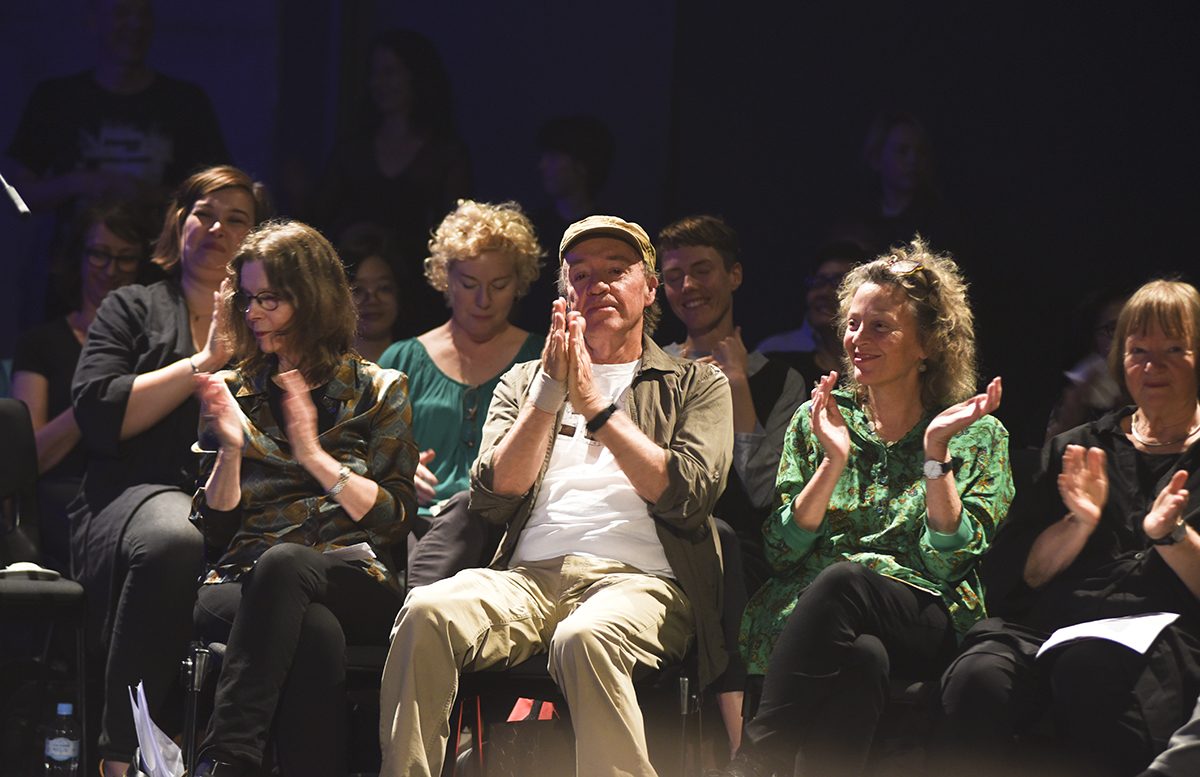
L-R: Justine Shih-Pearson, Virginia Baxter, Erin Brannigan, Richard Murphet, Cleo Mees, Sarah Miller, Clare Grant, RealTime in real time, photo Heidrun Löhr
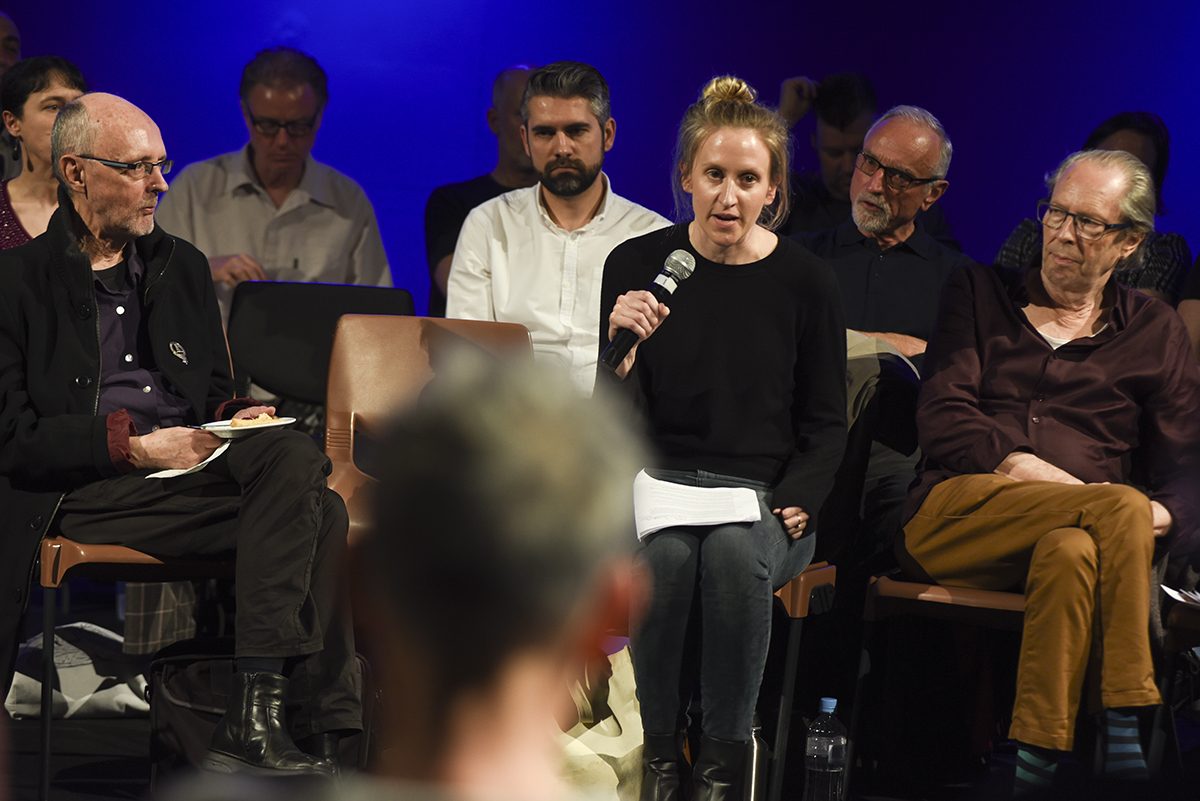
L-R: Stephen Jones, Ben Brooker, Caroline Wake, Chris Reid, Keith Gallasch, RealTime in real time, photo Heidrun Löhr
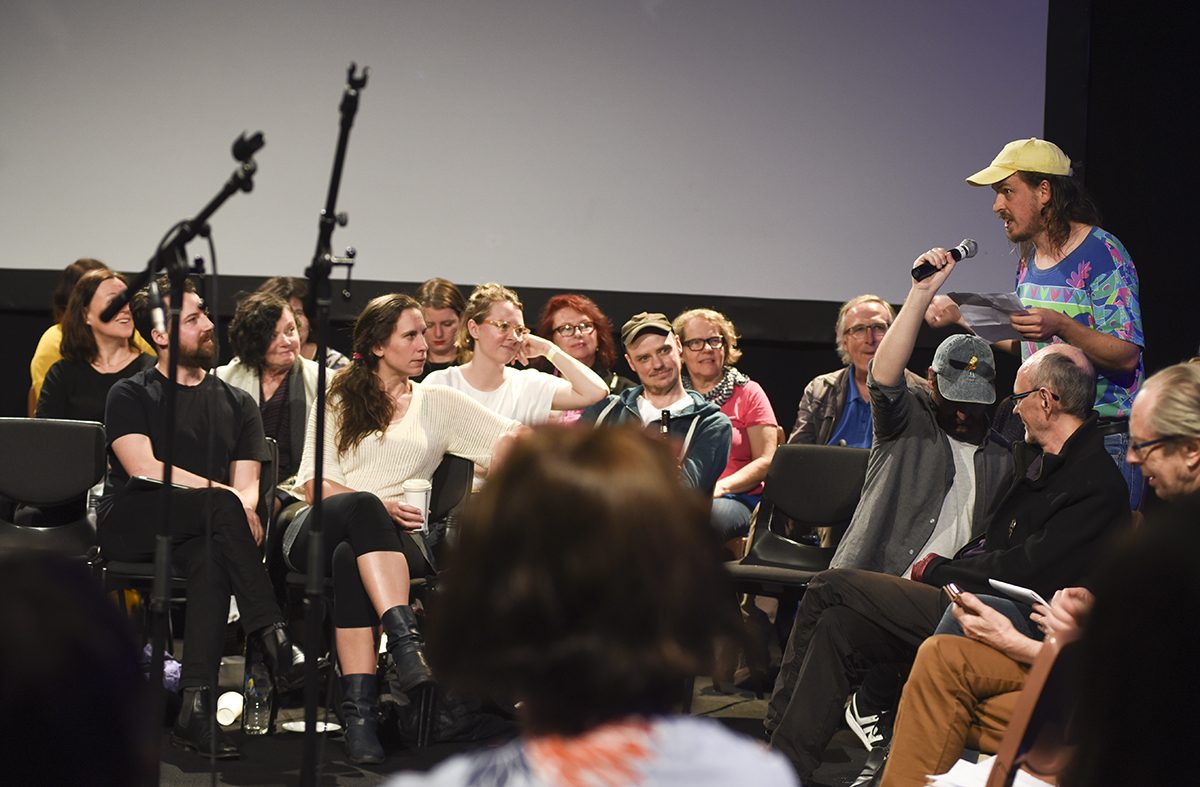
Performer: Malcolm Whittaker, RealTime in real time, photo Heidrun Löhr
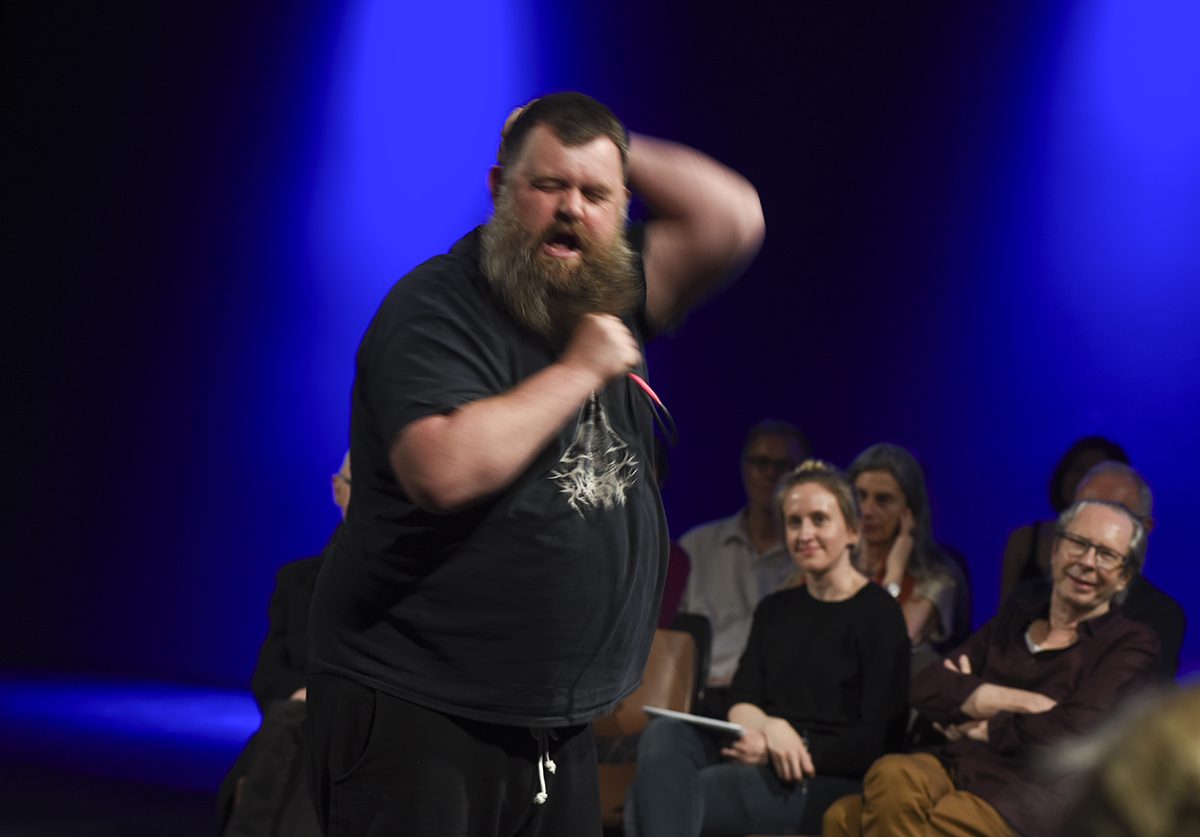
Performer: Andrew Harper, RealTime in real time, photo Heidrun Löhr
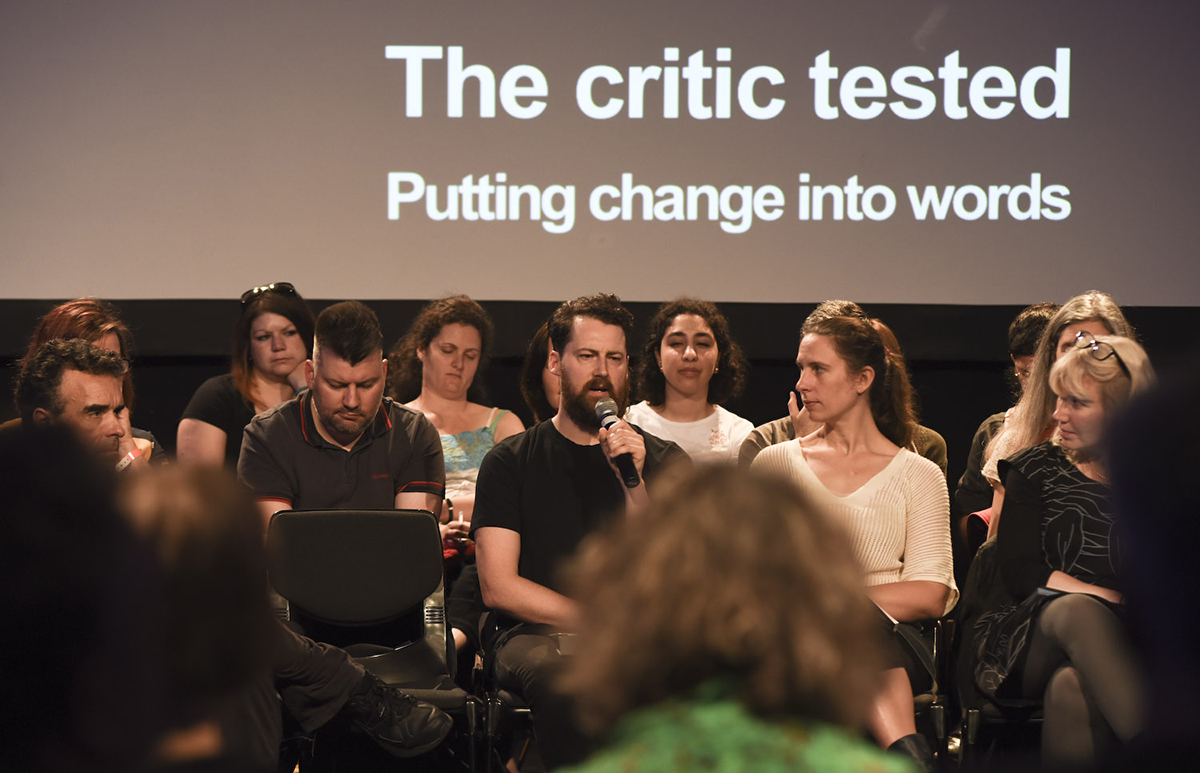
L-R: Richard Allen, David Williams, Mathew Lorenzon, Felicity Clark, Gail Priest, photo Heidrun Löhr
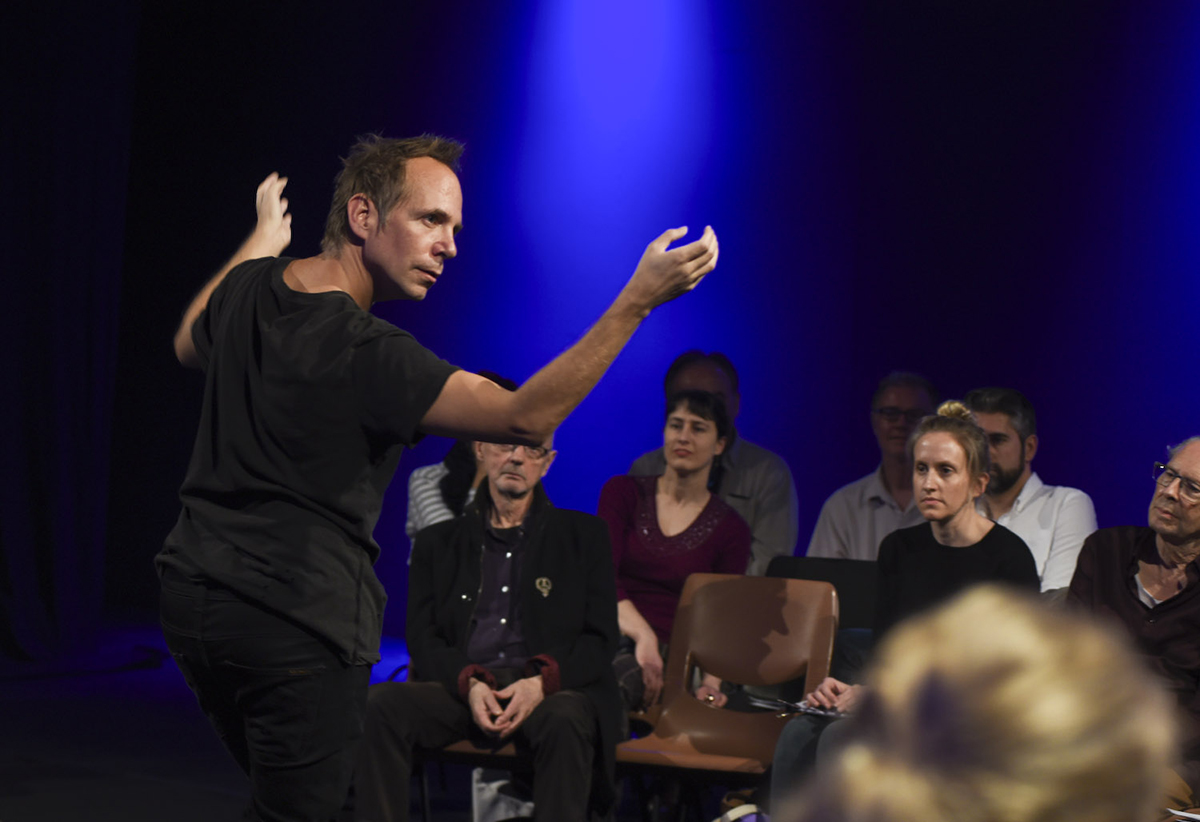
Foreground: Martin del Amo; background: Stephen Jones, Katerina Sakkas, Caroline Wake, Keith Gallasch, photo Heidrun Löhr
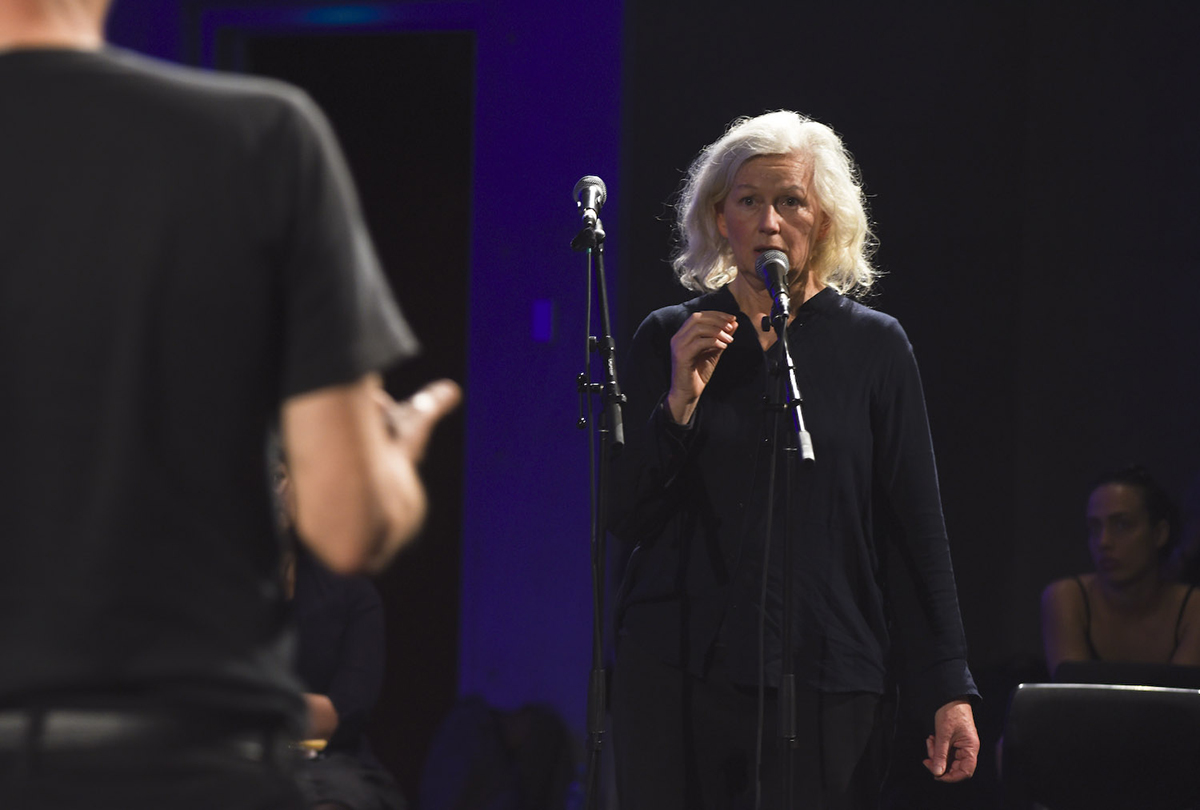
Nikki Heywood, photo Heidrun Löhr
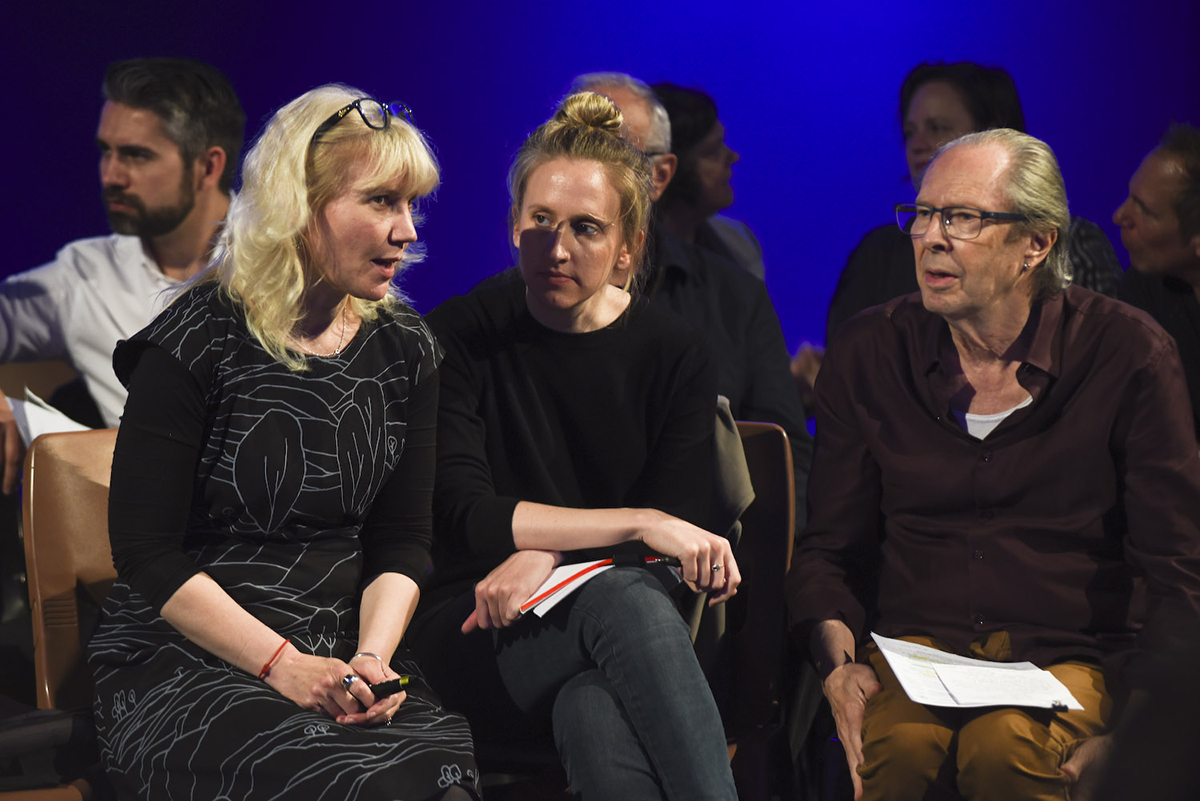
L-R: Ben Brooker, Gail Priest, Caroline Wake, Keith Gallasch, photo Heidrun Löhr
–
Performance Space, Liveworks Festival of Experimental Art 2018: RealTime in real time, Carriageworks, Sydney, 21 Oct
Top image credit: Foreground: Nikki Heywood, Tony Osborne; Mid: Greg Hooper, Andrew Fuhrmann, Jana Perkovic, Background: Angus McPherson, Kathryn Kelly; RealTime in real time, photo Heidrun Löhr
In this second instalment of Writers read RealTime we bring you four more of the actual voices of our contributors reading reviews of favourite works: Ben Brooker, Erin Brannigan, Urszula Dawkins and Zsuzsanna Soboslay.
You’ll find readings by Chris Reid, Gail Priest, Jonathan Marshall and Dan Edwards in Writers read RealTime in the RealTime Audio section of our online archive. The project is curated by Gail Priest who also composed the title score.
Ben Brooker: A rigorous engagement with Asia
Ben Brooker takes you deep inside four works in the 2015 OzAsia Festival, the first under the direction of Artistic Director Joseph Mitchell whose focus on cross-genre and cross-cultural performance and transnational engagement was immediately evident. Audiences live out Indonesian street life with Indonesia’s Teater Garasi, grapple with an overwhelming flow of digital data in Ryoji Ikeda’s Superposition, ponder the metaphysics of the collaboration between Australia’s Dancenorth and Japan’s Batik in Spectra and, raincoated, are awash with water, tofu, seaweed and everyday junk in a “spectacle of self-eviscerating excess” in Miss Revolutionary Idol Berserker from Japan.
RealTime issue #130 Dec-Jan 2015
Top image credit: The Streets, Teater Garasi, photo courtesy the artists and OzAsia 2015
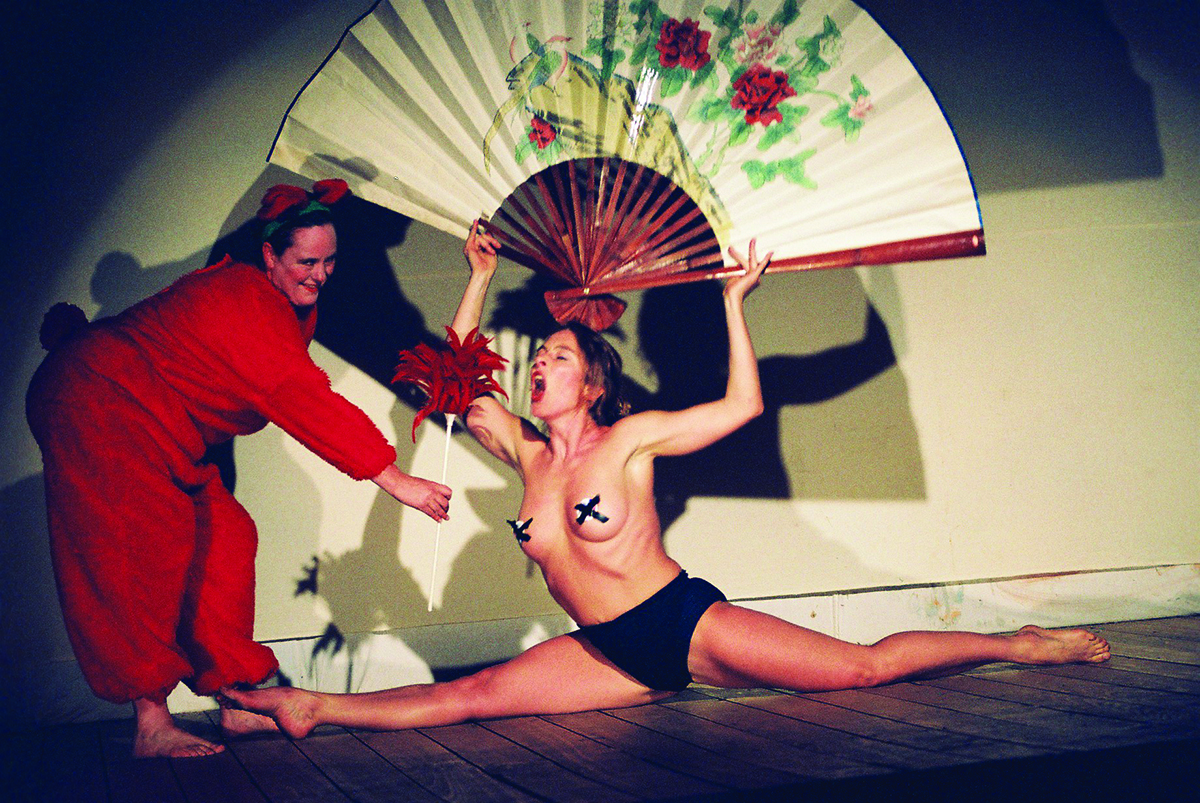
Julie-Anne Long, Kathy Cogill, The Nuns’ Picnic, photo courtesy the artists
Erin Brannigan: Nunsense in Hill End
In 2005 in Hill End, five hours out of Sydney, Erin Brannigan is continually surprised and thrilled by Julie-Anne Long’s The Nun’s Picnic, encountering in the tiny town a flock of nuns (with sexy underwear and travelling to “Like a virgin”), evocations of inner spiritual life and an hilariously provocative, and locally controversial, night-time performance by a stellar cast.
RealTime issue 65, Feb-March 2005
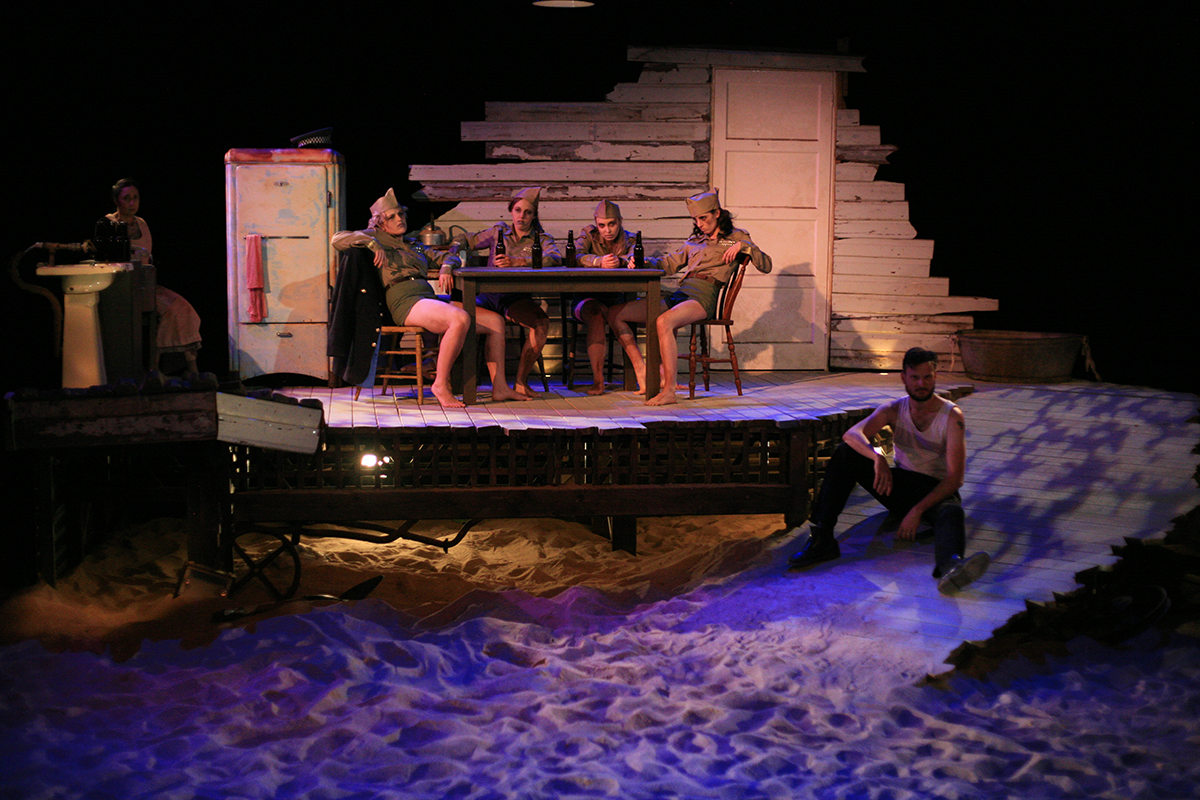
Heart of Gold, production photos Kim Tran
Urszula Dawkins: Westralia fantasia
Feeling at first outside her comfort zone when having to review a musical —Thea Constantino’s Heart of Gold at PICA – Urszula Dawkins is quickly taken with this allegory of a quest for independence staged in the town of Paucity. The luscious writing, fine performances and direction that stretch the musical form yield, more than madness and satire, a bleak poignancy in a world where patriotism runs riot.
See images and video from the production.
RealTime issue 94, Dec 2009-Jan 2010
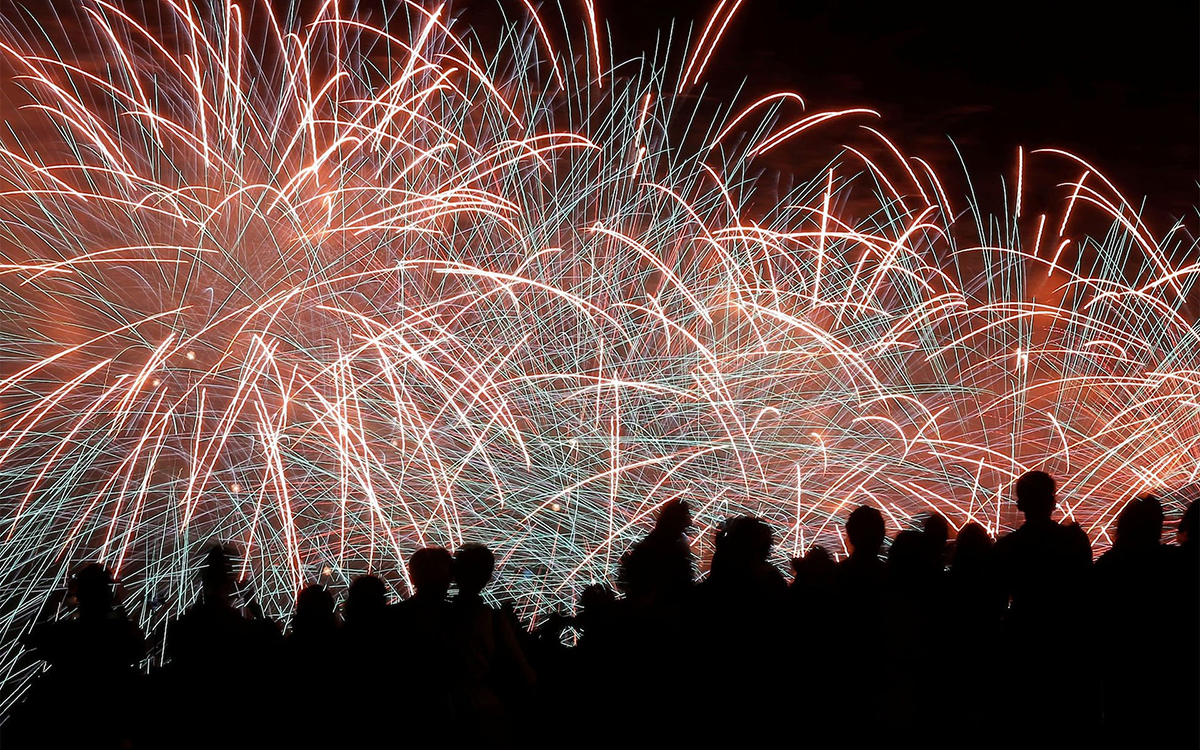
Zsuzsanna Soboslay: Beautiful violence
At LIFT (London International Festival of Theatre) in 1997 as part of a joint RealTime-British reviewing team, Zsuzsanna Soboslay incisively conveys her experience of Christophe Berthonneau and Group F’s, Un Peu Plus de Lumiere (a little more light), a fireworks creation in Battersea Park, as a work at once “awful and aweful,” conjuring, beyond beauty, “Vietnam with napalm, London with firebombs.”
The RealTime LIFT 1997 coverage, including this review, will soon be available in our archive.
Of the eight shows I saw, the greater part of this year’s Liveworks Festival of Experimental Art, I was most taken with two that most palpably extended form and response: Branch Nebula’s High Performance Packing Tape and Rianto’s Medium. I also greatly appreciated works by John A Douglas, Appelspiel and Asuna that took me to unexpected places.
Shortage of time, however, did not permit me to respond at length to the following works. I admired Angela Goh’s cool, witty, allusion packed Uncanny Valley Girl (see reviews in Running Dog, Runway Conversations and Art and Australia). I was bemused by Nicola Gunn’s sardonically quizzical Working with Children if wondering why, on the night I saw it, it didn’t commence with the artist sliding across stage on water as reportedly she did in the Melbourne season (it happened towards the end here). I suspect this undid the thematic and physical tension provided by a slippery surface undercutting the bland, repetitive movement of the work’s first part (see Jana Perkovic’s appreciative review for The Guardian). Tawainese choreographer Su Wen-Chi’s Infinity Minus One was meticulously performed by pairs of Indonesian musicians and dancers, the latter performing precise worshipful supplication and obeisance and then warrior-like aggression towards each other in a universe perhaps something other than Buddhist, its nature characterised by laser beams which never quite meaningfully intersected with the performance in this art-science exercise. All of these works tested me in ways that experimental art should, making for yet another fine Liveworks.
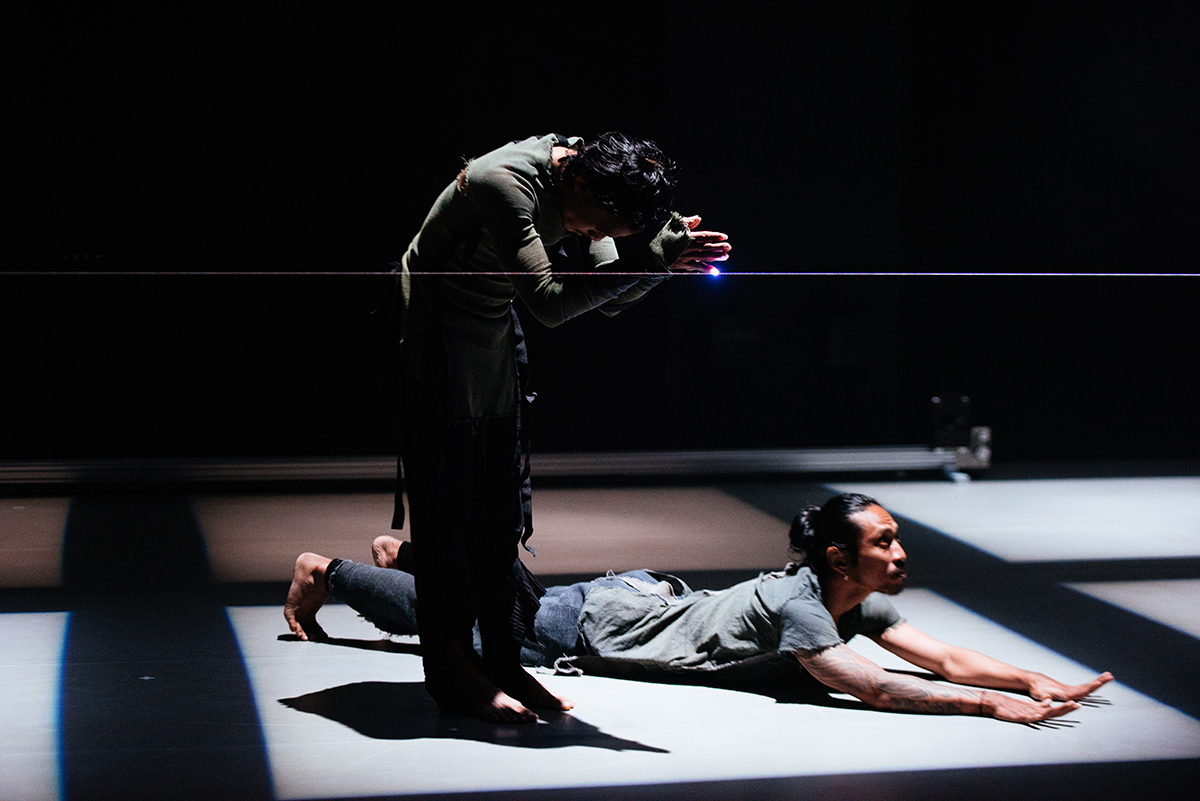
Infinity Minus One, Su Wen-Chi, Liveworks, photo Etang Chen
Branch Nebula, High Performance Packing Tape
In Sydney company Branch Nebula’s High Performance Packing Tape a bespectacled man (Lee Wilson or Lee Wilson as worker) in shorts and t-shirt shifts and stacks empty boxes. He carries an incredibly tall, tilting pile from one space to another. Collapse seems inevitable. He’s indifferent. He neatly piles five or so layers of empty boxes and attempts to climb the whole, twice crashing to the floor — not from a great height, but dangerous enough. He moves on, rigging a tightrope between two poles, the ‘rope’ manufactured live (more work) from large rolls of clear packing tape screechingly and rapidly unfurled between the poles, over and over and, amplified, generating a tense musicality, reinforcing the suspense as the worker executes this task atop a row of barely stable plastic chairs. A mass of noisily inflated balls provides a substitute safety net beneath the taut tape and the walk is embarked on with spectacular results and escalating risk as a box cutter comes into play. Work has thus mutated into circus and will ultimately evoke performance art at play with bondage: not done with the packing tape, the worker, now naked and suspended, cocoons himself in it into a ball of flesh. Done, he one-handedly hoists himself high on a length of woven tape. The box cutter blade slashes (men in the audience wince at the proximity to the scrotum). Incredible, unexpected release. You had to be there.
But it’s not all hard work. In an intriguing earlier scene the worker totally armours himself with bubble wrap, tops it with a milkcrate helmet and wreaks havoc on the boxes with his tape-made whip. Curiously, it’s the one scene in which health and safety are granted palpable priority and playfulness is allowed the worker as action hero defeating the evil that is cardboard (metaphorically all that is dangerous in the workplace). Otherwise he utterly subjugates himself to and tests his capacity to dominate the materials (there are many more than tape and cardboard in this production) and working conditions to which humans have tortuously bound themselves.
For a company committed to explorations of the nature of work and of play as art, High Performance Packing Tape represents a superb synthesis of these preoccupations and the apotheosis to date of Branch Nebula’s creativity. Lee Wilson’s worker is indefatigably industrious, skilled, inventive and risk-taking, facially expressionless, never a clown in this serious circus of the working life. Mirabelle Wouters’ design conjures monumentality out of boxes, air-pumps and exercise balls as does Phil Downing’s amplification and manipulation of the sounds found in Wilson’s labours.

Rianto, Medium, photo Wannes Cré
Rianto, Medium
Well into his performance of Medium, Rianto, suddenly directly in front of us, sweating, for the most part naked, arches forwards, chest and groin pushing out, head back, arms wide, hands sweeping, as if urgently in search of breasts and womb that cannot be found. The act is impassioned but seemingly unconscious. Rianto is in a trance state, self-induced in the performance’s commencement and from which spring the key motions of Lengger, a Javanese dance in which men perform as women. It’s a folk dance, but one richly and exactingly imprinted with the steps and highly articulated gestures of courtly dance; within it Rianto becomes a princess but also her long-awaited warrior prince lover. None of this is literalised; rather it is embedded in a contemporary dance performance.
For those lucky enough to have seem the Indonesian artist’s performance lecture in 2016’s Liveworks, in which, at first fully costumed, Rianto illustrated each aspect of Lengger choreography, much of Medium’s dance was thrillingly recognisable. In that performance, removing masks and layer after layer of deep-folded costuming, he also revealed the inherent ambiguity of his private relationship with a female self, but not with the seismic intensity of this twice enacted moment of fraught possession in Medium. Medium also took us deeper into Lengger’s transformative potential as a shaman-like Rianto becomes a bird, finely mimed and vocally articulated. Further ambiguity ensues when Rianto’s superb collaborating musician, Cahwati, casually takes to the stage as princess to his prince, passing her string bow across his body — either erotic stroking or defiant distancing.
Rianto’s meticulous, highly engaged performance, its sustaining and expanding of tradition and that deeply strange feeling of entering a less than conscious world in which the dichotomies of gender dissolve, re-form and dissolve again, these make a for a great work. For a more detailed account of Medium and its context, see Ben Brooker’s review for Witness.
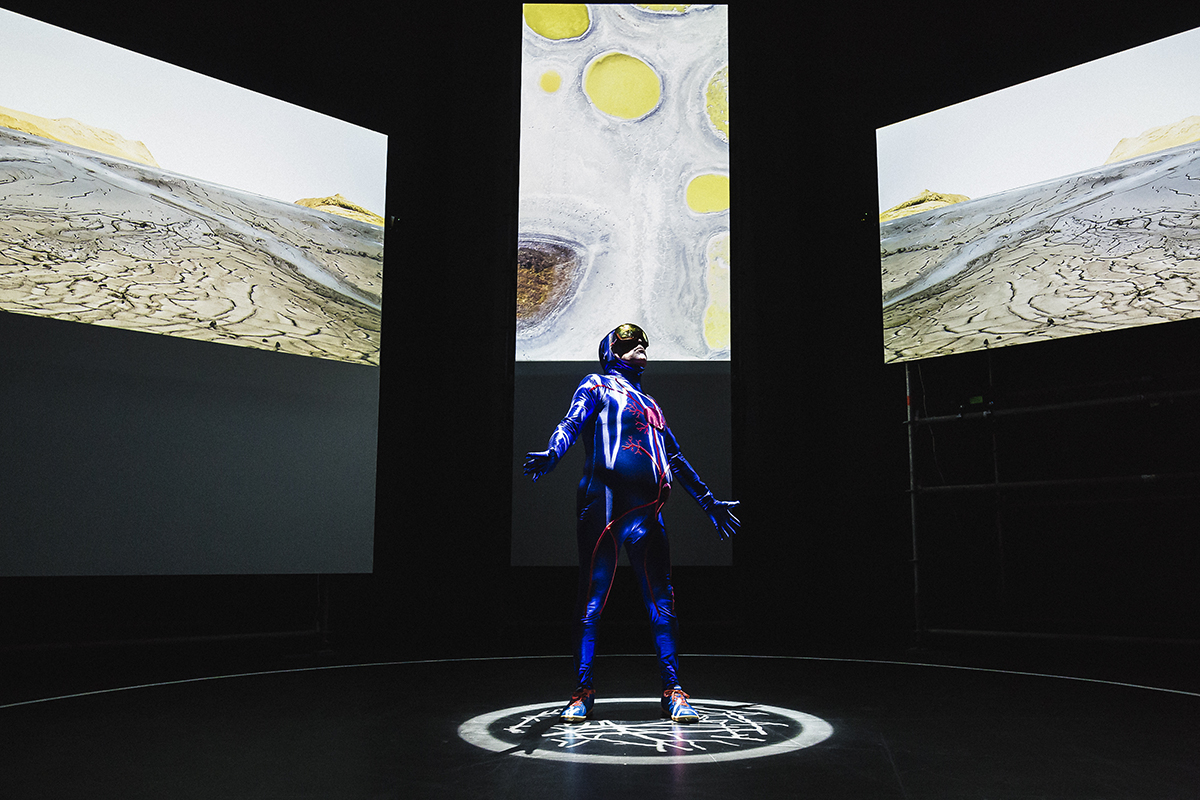
John A Douglas, Circles of Fire: The Amphitheatre, Liveworks, photo Gotaro Uematsu
John A Douglas, Circles of Fire: The Amphitheatre
John A Douglas’ Circles of Fire represents, in its collective modular forms (installation, durational performance art, VR and performance), a provisional triumph over disability in a body bearing a transplanted kidney and requiring constant medication, exercise and psychological assimilation. In the durational Cannulation Performance we witness a totally white-bandaged Douglas administered an intravenous drip by nurse and performance artist Stella Topaz. Douglas’ movement is limited to a slow downward tilt of the head while his free arm travels almost imperceptibly down across his torso, evoking the body at its most damaged and vulnerable, but cared for with a simple touch from his nurse. What plays out on the three screens suggests that this almost stilled being has a remarkable interior life — vast deserts, volcanoes, salt lakes, lush forests, ancient ruins variously evoking phases of agony, comfort and transcendence. These images of sites that seemed for the artist “to resonate as places of solace and healing,” were taken from around the world by the artist himself.
The 30-minute Amphitheatre Performance is a complex creation structured around the stages of Douglas’ illness, its viral beginnings (“Nausea”), the nearness of death (“L’Eclisse”) and the battle to live, venturing on to “Normalising the Body” and resolving in a climactic “Victory Lap.” On the trio of screens the landscape images recur, Douglas occasionally appearing in the distance or racked with nausea between the columns of a Roman ruin. New images appear: threatening eclipses, a contrasting, otherworldly floating iridescent ball. Onstage, Douglas struggles to merge with the projections, leaning with slow turns, arms raised, into the lower ones and scaling the scaffolding of the high central screen. But in the performance’s final stages, newly attired in a dazzling blue Lycra bodysuit on which is vividly embroidered in red the replacement kidney and connecting artery, Douglas appears as a triumphant super hero, astride a wide circle, at first a black hole, but then patterned and around which he runs with agility and a sense of security. He remains masked and wordless, but the expressivity of body, imagery and soundtrack suggest a newly found well-being and oneness with the body (even one inhabited by alien DNA) from which he had been so brutally distanced. The power of Circles of Fire: The Amphitheatre resides in the dynamic interplay between a singular, suffering body and the cosmological totality of images resonant with the artist’s pain, expressing it but also offering consolation and a place in the universe. Douglas’ extensive creative team, led by producer Bec Dean, has done the artist proud in assisting him to realise a magically enlightening phantasmagoria. (Read an interview with John A Douglas.)
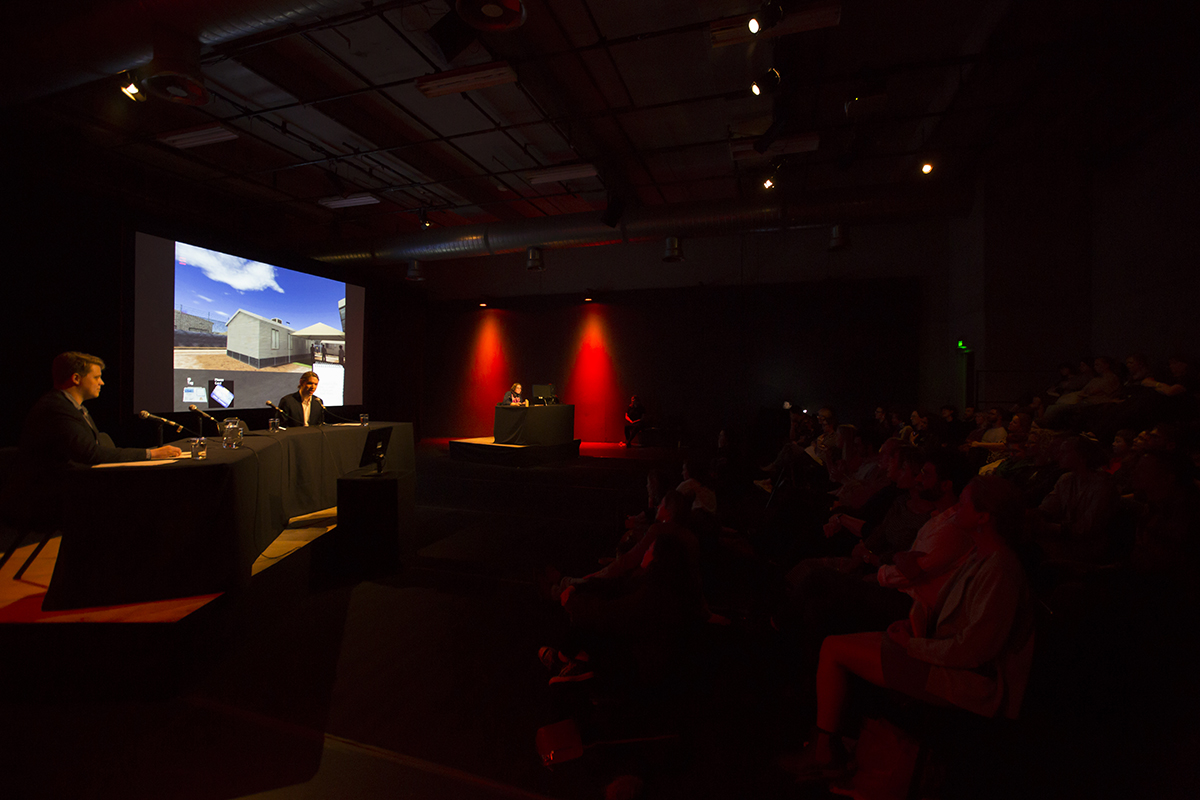
Return to Escape from Woomera, Applespiel, Liveworks, photo Alex Davies
Appelspiel, Escape from Womerah
In Escape from Woomera, Sydney performance ensemble Appelspiel engagingly fuse computer gameplay with a talk show format over several hours. As individual players attempt, one at a time, to assist a video game refugee to escape the infamous Woomera detention centre (projected onto a large screen), amiable Appelspiel members host a discussion with guests: on the night I attend they are Australian barrister and refugee advocate Julian Burnside and writer Creatrix Tiara, who, among other things, has made games about immigration. The conversation is rich in anecdote and alarming information, frequently focusing on Australia’s failure of empathy and the illegality of our treatment of legitimate asylum seekers as “illegals.”
Our attention switches between panel and screen; alert audience members are quick to point out progress and on this night there was near success. Appelspiel fill us in on the 2003 video game, Escape from Woomera (makers Mark Angeli, Julian Oliver, Ian Malcolm, Stephen Honegger, Kate Wild and Morgan Simpson), much more sophisticated than I’d imagined, and the then Coalition Government’s objections to its Australia Council funding (the council disowned the work) and alleged potential to trigger an actual escape. As players finish their games, Appelspiel members interview them about the experience. The player who nearly succeeded admitted that he had to put aside feelings for the characters he was engaging with in the detention centre in order to play the game as hard as he could.
Although it could be argued that Return to Escape from Woomera is one for the converted, it’s vital that the assumedly converted become more deeply informed, see the issue from a wider range of perspectives and, for younger audiences, be mindful how little has changed since 2003. Appelspiel offered us that opportunity, especially for those prepared to stay for an hour or two or three of dialogue, including with the audience (with reflections on this night from Yana Taylor, one of the creators of Version 1.0’s A Certain Maritime Incident) and contemplation as an alternative to ingesting a few daily news bites.
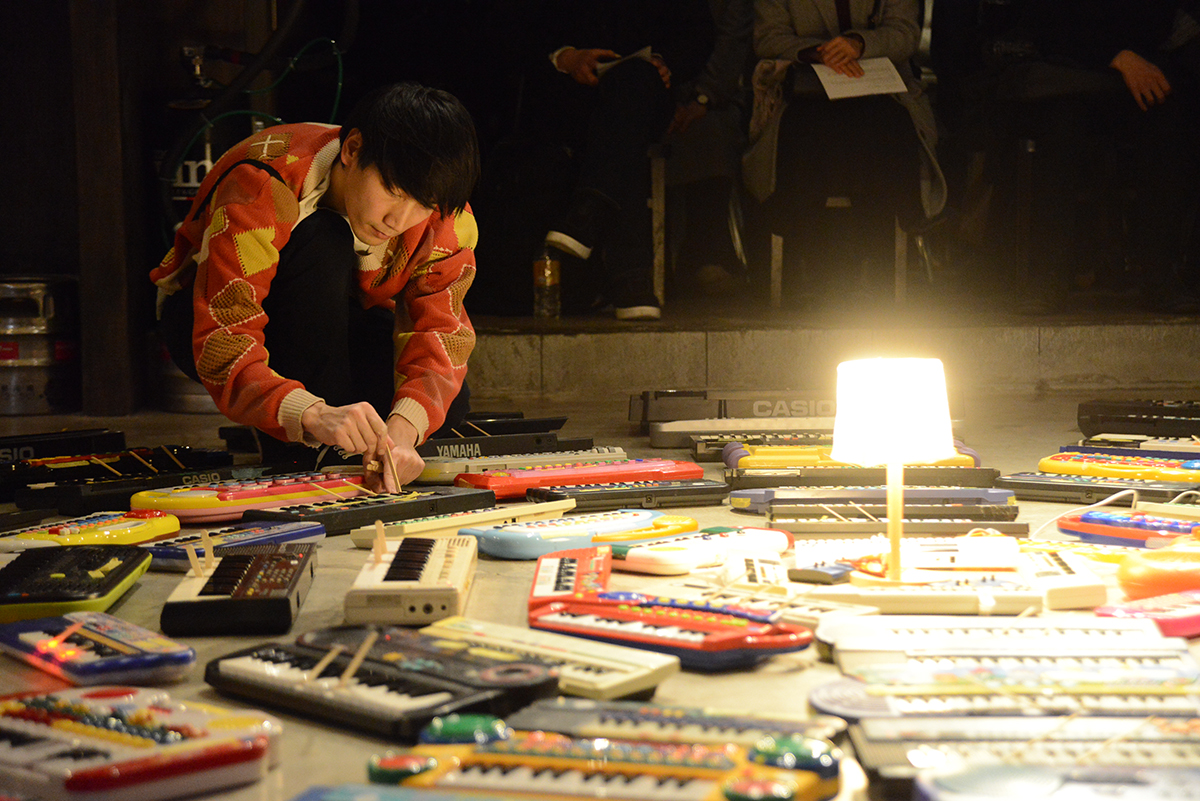
Asuna, 100 Keyboards, photo Ritsuko Sakata
Asuna, 100 Keyboards
Japanese sound artist and experimental musician Asuna, like Lee Wilson in High Performance Packing Tape, is another man tirelessly at work, in this case revealing the collective potential of his battery-operated keyboards, mostly toys and other portables. The instruments are packed into a large circle through which the artist delicately moves, turning on one at a time, setting controls, locking keys into place with wooden ice cream sticks, returning obsessively to particular machines, leaning in and listening attentively, making adjustments, moving on. The first sounds are predictably thin, reedy, buzzy, but as more machines are activated the sound grows denser seemingly filling with incidental chords and harmonies. According to Asuna, “Multiple sound waves on the same frequency are disseminated in multiple directions, creating a complex distribution of acoustic pressure” (program note). Consequently he encourages us to wander the space to register “subtle variations of sound interference and resonance.” The shifting coalescence of humble sounds assumes an immersive, richly textured orchestral presence exuding, unlikely as it would seem, deeper notes and hinted rhythms. In the final phase, Asuna slowly reduces volumes, unpicks sticks and switches off his devices down to the very last, but unlike the beginning where the sounds seemed innocently toy-like, notes now sound substantial and complex resonances linger like a beatiful haunting. A weary Asuna tosses us ice cream sticks as mementoes.
–
Performance Space, Liveworks Festival of Experimental Art, Carriageworks, Sydney, 18-28 Oct
Top image credit: Lee Wilson, High Performance Packing Tape, Branch Nebula, Liveworks, photo Heidrun Löhr
I am a failed novelist who was always too distracted to complete a full draft. My unfinished and unpublished novels include Brian and the War of Stillness, The Captain: An LSD Story, and Travels of a Tasmanian Tiger in an Age of Extinction. Eventually, it became too difficult to be a failed novelist and still receive unemployment benefits, so I went to university and stayed long enough to do a PhD on Immanuel Kant and science fiction. While doing a PhD my friend and former Papunya Tula field worker Chris Durkin came to visit and was trying to impress my housemate with his collection of Papunya Tula paintings, rolling them out on my bedroom floor. This was a turning point for me as I realised that art was being produced in Australia of a quality to compare to any made in New York or Paris. I then got a job at the University of Western Australia and have since focused on writing about visual art from remote Australia, including co-authoring Wanarn Painters of Place and Time (with David Brooks, UWAP, 2016), co-editing Indigenous Archives (with Ian McLean, UWAP, 2017) and editing Bush Women (FAC, 2018).
I think my writing has become a lot better since writing for a readership rather than for my housemates, and especially since RealTime gave me my first chance to write regularly in 2008. Since then, I’ve reviewed and written on Australian visual arts for Artlink, Eyeline and other arts publications, as well as for academic journals, most recently especially for World Art. Working for a University is a real luxury as I can support a family while working on what I love to do, which is to read, write and research, as well as talk about art and the way that it opens up possibilities for seeing the world anew. At the moment I am focused on drawings and carvings from cattle and sheep stations in Australia, dating back to the 19th century. Sometimes, these possibilities for seeing the world anew lie not in the future but in the past, that is often as science fictional as anything from outer space.
Exposé
In my day job I work as an ‘art historian,’ which means trying to write artworks into their contexts. Such writing means that you place a certain distance from yourself and the art that you are writing about. This kind of practice has been critiqued for its ‘mastery’ both of art and of history, for its claims to the ‘truth’ of art. Previously I’ve been a newspaper art critic, a classic case of ‘mastering’ art as week after week I judged exhibitions, arguing in a few hundred words whether they were good or bad or a mix of both. A third kind of writing (next to art history and art criticism), and one that RealTime has long fostered, is ‘art writing,’ a nebulous sort of practice that tries to stay with the experience of the artwork, becoming a part of its life and its memory. I always appreciated the way that RealTime wanted to collapse the distinctions between art and its representation as much as possible, as well as those between types of art, whether it be writing, performance, exhibition, or whatever. After all, the difference between a gallery and a theatre is a way of keeping art in its place, of keeping ideas from changing people, and people like artists from changing the world.
Recent articles for realtime
Decibel and the new classicism
Road rage art
Experimental art—having to speak for itself
War, nostalgia, utopia
Climbing Art
I wrote around 40 reviews for RealTime between late 2008, when I was finishing a grad dip. in journalism, and early 2016, when a bicycle crash changed the shape of both my left hand and my working life — though, thankfully, not permanently. In that time, I accepted RealTime commissions that exposed me to singing sausages [Heart of Gold The Musical, RT94] and ‘cyberdada’ [Cyberdada Retrospective, RT110], cocktails made of snail foam [Wilderness Adventures for the Palate, RT107] and high Romanticism with animal costumes [NDINAVIA, RT89] — all in the service of documenting Australian hybrid and experimental arts.
What ties all these articles together? Ruminating at length on this, I finished up with two threads: my abiding interest in how we inhabit, explore and generate places and their atmospheres; and, obviously but not insignificantly, a habitual commitment to ‘saying yes’ to whatever Keith and Virginia asked me to do. So, below, some organising of the resulting ‘landscape’ — a three-part reflection on works that took me places, metaphorically and literally; immersed me in atmospheres both environmental and digital; and carved out spaces for both the marginal and the personal.
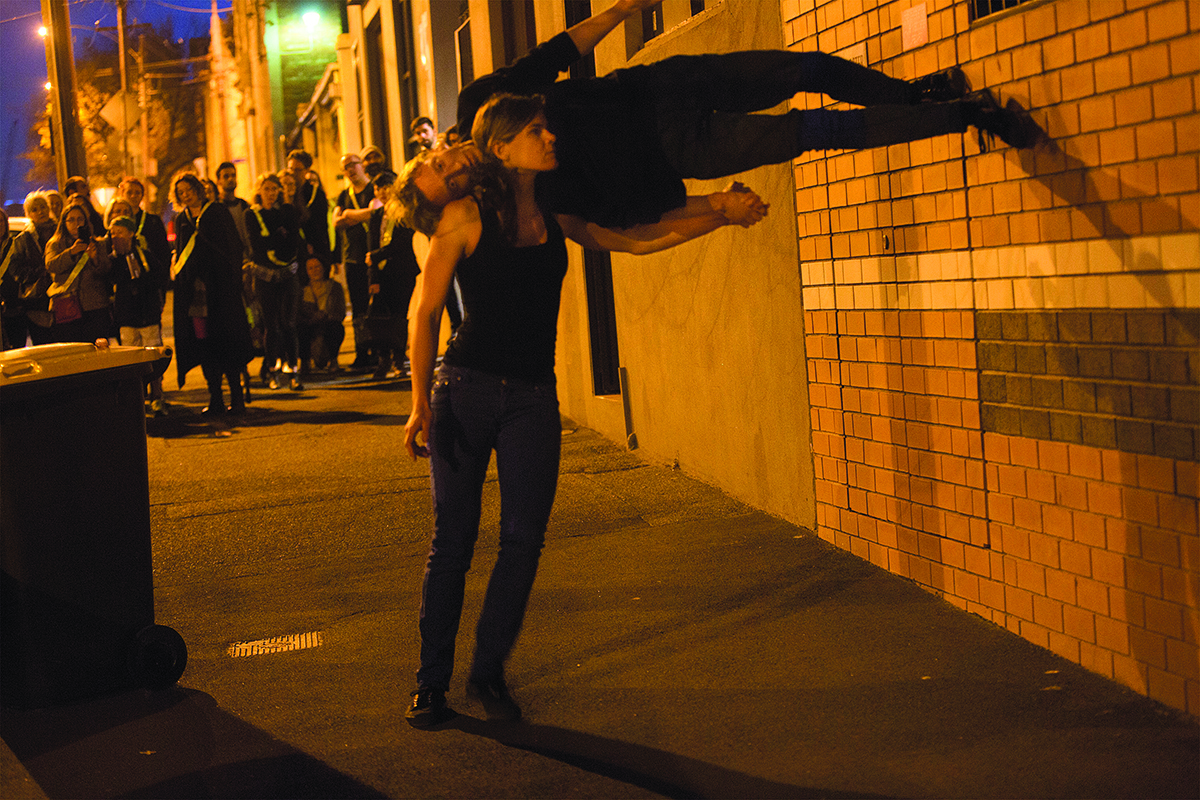
Naomi Francis, Skye Gellmann, Bodies over Bitumen, photo Ponch Hawkes
Place/space/ritual
Taking up space, messing with and re-presenting it, site-specific works are both demarcations and modifications. At Melbourne Fringe 2015, Skye Gellmann, Naomi Francis and Alex Gellmann took their circus skills into the back streets of North Melbourne in a subtle, fugal reclaiming of the built environment, Bodies over Bitumen RT [130]. “With histories spanning homelessness, squatting and street daredevilry, [the] creators are credentialled with lived understandings of space and who it belongs to, as well as how to claim and disrupt it. With a shared language born of past collaborations, they create a mood sometimes of aimlessness, sometimes of interrupted purpose, and equally of experimental occupation.” From virtuosic pole work (on a parking signpost) to “space-eating” aerials and a nerve-racking scene in which the performers lay spread-eagled on the road in “a poetic and visceral pause,” Bodies over Bitumen took purposeful ownership of the site; walls, fences, roundabouts, tarmac and all.
Intervening rather than occupying, Gabriella Mangano and Silvana Mangano’s Hidden Spaces, Ready Stages [RT116] seemed to attempt to turn bodies into space, as the artists explored and exposed the labyrinthine recesses of Melbourne’s Arts Centre. Large video screens set inside the cavernous, raw-concrete shell of the Arts Centre’s Riverhouse displayed vents, pipes, tunnels and columns, in which human figures appeared almost “as if…trying to ‘be’ the space.” James Brown’s groaning, clanging, pulsing soundtrack felt both industrial and “uncannily evocative of nature,” by turns “palpating the air” and “seemingly sucked down through the vents from foyer to pit to boiler-room.” Hidden Spaces, Ready Stages “inserts the human into the void, the artists spelunking into spaces designed never-to-be-seen-or-heard,” as these bodies attempted to meet the “impenetrable (though now-penetrated) edifice.”
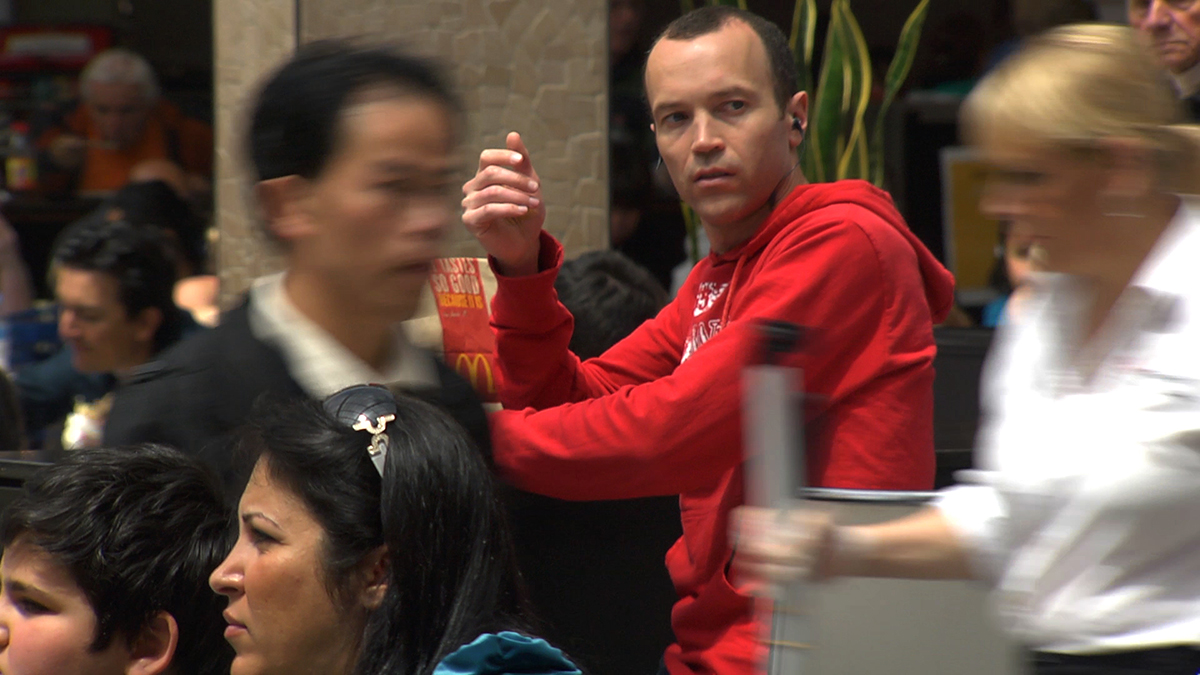
Tom Davies, PUBLIC, concept/direction Tamara Saulwick, video still courtesy the artists
Sound was a crucial element in the transformation of another cavernous space — the Highpoint Shopping Centre food court, in Melbourne’s inner west — when Tamara Saulwick, with sound designer Luke Smiles, presented PUBLIC, also in 2013 [RT119]. Issued with closed headphones, audience members were sent into the food court, where the soundtrack – partly live and partly pre-recorded – provided clues to where each of four performers moved. We eavesdropped as they came together to talk about chatbots, girls getting engaged and guys on late shifts…with the dance track “I Feel Love” providing a steady, heady backbeat. “Hundreds of unpaid extras” added their noodle-slurping, ice-cream-licking, napkin-crumpling gestures to the scene, “the rhythms of banal exchange [elevated] to the level of music or poetry.” And yet, despite an increasingly surreal feeling as the performers’ actions escalated, “the work strikes me as almost ‘representational’ — ‘depicting’ the space, if you will, in larger-than-life tones.” Place and people, public and private all merged; location and community still felt strangely fused well after the ‘performance’ was over.
Zoe Scoglio’s MASS, part of Field Theory’s Site is Set 2015 [RT129], extended ‘location’ to take in the cosmos, transforming the crumbling Calder Park Raceway into an auditorium fit for a ritual reflection on consumption, connection and our place in the universe. MASS centred our attention on cars — in Scoglio’s words “metal shells, fleshy inside, shiny outside, fossil-fuelled,” under a rising full moon. Sixty carloads of spectators followed an ‘Order of Service’ that included choreographed parking on a shabby backblock, and an ascent and descent of the raceway embankment on foot to view weed-covered seating banks on one side and darkening city skyline on the other. Via a soundscape played on car radios and through mobile headphones, we were indoctrinated on our “anthropogenic impact” and our relationship to the rocks of the earth itself. At the height of the ritual, “[s]winging censers exhale clouds not of frankincense, but the scent of burning rubber. As MASS ends, we’re reminded of our collective intimacy: we are connected, geological objects whose mutual gravitational pull will now begin to weaken.”
Gatherings make spaces
If places generate atmospheres in and of themselves, gatherings held at particular places/times overlay and expand them, their fleeting energies temporarily releasing ephemeral genius loci of various kinds. At themed events like the first Channels Video Art Festival [RT118], SymbioticA’s Body/Art/Bioethics Symposium [RT99], the Asian Producers’ Platform Camp in Seoul [RT125] and Curtin University’s 2010 symposium and exhibition, Art in the Age of Nanotechnology [RT96], discrete convergences of time/place were steeped in experimentation, provocation, collaboration and simulation, respectively.
Art in the Age of Nanotechnology, in particular, immersed visitors in the super-high-technology of nanoparticles, observed, harnessed and explored in artworks that included Victoria Vesna and James Gimzewski’s hypnotic Nanomandala. To create the work, monks from the Tibetan Gaden Lhopa Khangtsen monastery in India worked full-time for a month building a richly coloured sand mandala, which Vesna and Gimzewski then photographed at various scales, including with a Scanning Electron Microscope. The result is a seamless, slowly zooming projection that conveys viewers, over 15 minutes, from the “intricately rendered geometric patterns, human figures, tiny creatures and curling clouds” of the mandala towards “ever-growing grains of brightly coloured sand…a micro-landscape of boulders and edges, before the rich hues fade and we begin to ‘see’ at the nano-level — a scale at which colour itself ceases to exist and the sandscape becomes flakes and mounds of rippled grey and white” [RT96].
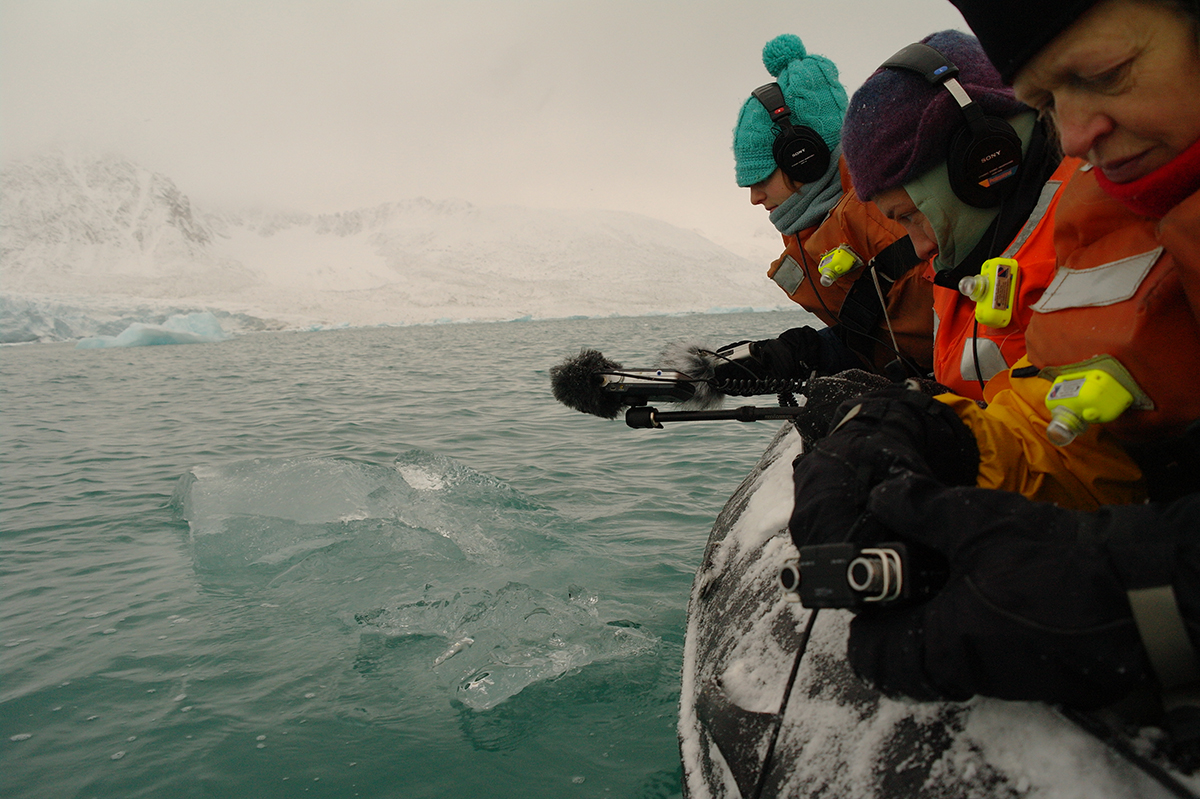
Interviewing ice, Arctic Circle Artist Residency, photo courtesy the artists
Later in 2010, I was lucky enough to take part in The Arctic Circle international artist residency, logging a report for RealTime from high-Arctic Svalbard [RT100], where 20 artists gathered to make sense of a place that seemed boundless and remote in the extreme. On-the-ground interventions (at times in thigh-deep snow) included Rebeca Mendez’s staking of a territorial claim for Mexico via a hapless, flag-posting ‘explorer’; Chad Stayrook’s ubiquitous appearances with foolishly gigantic cardboard ‘survey tools’; Carrie-Ann Bracco’s intrepid plein-air oil painting sessions, often undertaken amid blizzards; and Teng Chao-Ming’s marking out of an apartment-sized ‘home’ in the uninhabited ‘Advent City’, an utterly deserted mining town at around 78° North.
But of all the gatherings that ‘made place’ for me in short-lived but impactful ways as a RealTime writer, Sydney’s hosting of the international 19th Symposium on Electronic Art (ISEA) in 2013 topped the bill. With many dozens of exhibitions, performances, public talks and workshops, and what must have been hundreds of participating artists, ISEA 2013 seemed to amp up inner Sydney’s already high voltage: a creeping network of events that included myriad subsidiary place-makings in the form of themed group exhibitions — like ANAT’s Synapse: A Selection [ISEA-in-RealTime blog, 11 June 2013] and SymbioticA’s bio-arts-focused semi-permeable (+) [ISEA-in-RealTime blog, 10 June 2013], both at Powerhouse; as well as smaller shows like Echosonics [ISEA-in-RealTime blog, 14 June 2013] — an exploration of sound and environment — and the more esoteric If a system fails in a forest… [ISEA-in-RealTime blog, 17 June 2013].
Amid machinic, scent-producing ‘flowers’ [ISEA-in-RealTime, Gail Priest, 13 June 2013], a ‘Twitter meets the book arts’ cutting-and-pasting project [ISEA-in-RealTime, 16 June 2013] and a Skyped-in keynote address from Julian Assange [ISEA-in-RealTime blog, 14 June 2013], two works — one grand, one necessarily intimate — continue to resonate within the expansive ‘place’ that I remember as ISEA Sydney: Ryoji Ikeda’s seductive and profound datamatics (ver. 2.0) [ISEA-in-RealTime, 8 June 2013] and George Poonkhin Khut and James Brown’s Theta Lab [ISEA-in-RealTime, 13 June 2013].
Ikeda’s video work datamatics (ver.2.0) was “[a] near-monochrome diamond-cut of ones and zeros flying faster than the eye can grasp; an hour of heartbeat-paced, Morse-toned pips and subliminal surges.” “[B]lack screen, white bars, barcodes, churning letters and numbers, an infinite, ever-changing scroll of data” morph into spatial landscapes: “a mapped-out universe whose anonymous stars are sequentially named and positioned…What emerges from it is a profound representation of the impact of mathematics on the world, the endless grid of ‘knowledge’ that positions everything from clustering stars to swarming starlings.” In datamatics (ver.2.0), location existed in brilliant coordinates, as an architecture both minutely drawn and infinite in scope, “an almost tangible spatial realm between the data and its representation.”
To call Theta Lab an insight into ‘place’ is a stretch, admittedly; the ‘place’ experienced was the mind itself. “[A] real-time interaction between participants’ brainwaves and a responsive soundscape”, Theta Lab took place on a futon-like bed, in a darkened ‘pod’ that felt “like a monastery or a health retreat, minus the whale music.” Wired to an EEG monitor, my mission was to relax; my changing brainwave patterns — ideally producing what are called Theta waves —influencing a responsive soundtrack. The experience was “challenging, illuminating and intensely interactive…It’s just me and the neurofeedback system: a half-hour mental dance of confidence, calm, impatience, frustration, surprise, wonder and occasional self-punishment.” The resulting sounds, far from indicating inner calm, ranged from “a constant, throbbing murmur that travels through my whole body, to bell-like tones that seem to call a higher consciousness…[a] loud crackle…[and] beating bass tones… [A]t the end, feeling a little like I can’t drum up a Theta wave to save myself, I can only think, wow, is that what it’s like inside my head?”
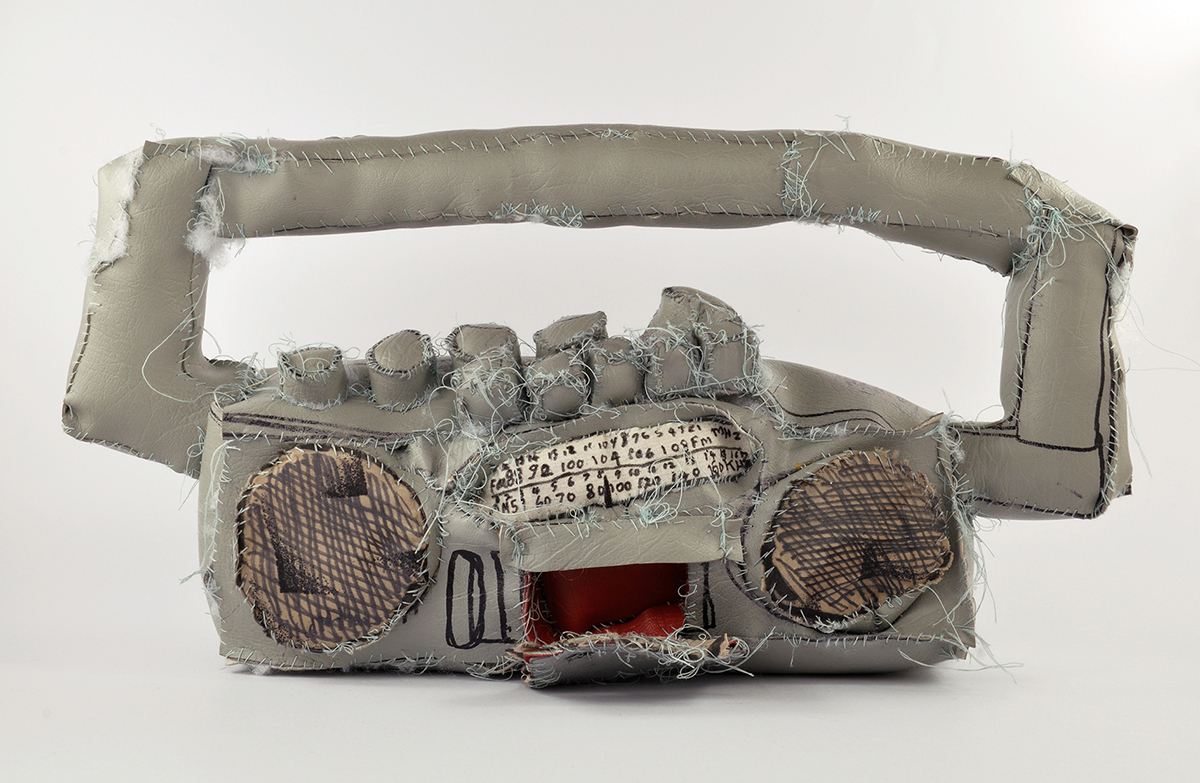
Stereo 2011, Terry Williams, private collection Melbourne, photo courtesy the artist
Carving out a place
Some of the most gratifying artistic ‘spaces’ are those that privilege the intimate, the personal and the marginal. For Everyday Imagining: New Perspectives on Outsider Art at the Ian Potter Museum of Art [RT125], curator Joanna Bosse brought together seven ‘outsider artists’ — so named as part of a tradition that has “embrace[d] the art of makers variously perceived as untrained, self-taught, intellectually or physically disabled, or otherwise marginalised from either mainstream society and/or the mainstream art world.” Paradoxically carving out a place ‘inside’ the art establishment, via this very status as ‘outside,’ these artists explored “the same everyday world that we all live in: a world of things, people, obsessions, doodlings, abstractions, patterns and geographies.” Their renderings ranged from uncannily accurate re-creations of household objects as fabric sculptures to intricate, flawlessly executed, hand-drawn patterns on graph paper that “shimmer like snowflakes or starfields.” They made new spaces as artworks always do: “shaping form out of chaos (see Elizabeth Grosz’s Chaos, Territory, Art); exploring representation, abstraction, topography.”
In Amelia Ducker and St Martins’ Genius [RT131], a group of children often labelled similarly as ‘outsiders’ — all on the autism spectrum – invited audiences into purpose-built, circular booths where they shared their expert knowledge and skills with their visitors, on topics as diverse as endangered Australian animals and the rhetoric of Gough Whitlam. In Genius, “the predictability of the format supports the possibility of our interaction; we are asked to [the creators’] worlds on their terms, not ours.”
The first work I reviewed for RealTime was Simon Terrill’s Crowd Theory – Port of Melbourne [RT87], a large-scale, community-focused photo shoot in which a ‘crowd’ formed by “locals, interested ‘outsiders’, port workers…and sundry others” got to “stake its tenuous claim…behind the wire fences.” The last was young Palestinian-Australian artist Aseel Tayah’s you are not a boy [RT131], a short outdoor performance in which Tayah told stories of women “mutilated, verbally abused, chastised or prohibited from speaking out” because they were ‘not a boy,’ while pinning squares of fabric inscribed with the Arabic word for ‘taboo’ onto onlookers’ clothing. Saying ‘yes’ to these and so many other commissions, over almost a decade, meant participating in worlds, and sometimes being drawn into making them: transformed sites, ephemeral destinations and the intimate landscapes of difference and togetherness in the places so created.
–
You can read about Urszula Dawkins here.
Top image credit: Crowd Theory – Port of Melbourne, 2008, Simon Terrill, produced in association with Footscray Arts Centre and Port of Melbourne, photo Matt Murphy
Threshold 1 (ageing):
Justus Neumann’s Alzheimer Symphony (2016) cuts to the heart of what we fear as we emigrate from one part of our lives to another — in this instance, crossing into old age and forgetfulness. For what is the value of a man, when his mind slips, his memory sags, his world becomes a cage?
The protagonist of Alzheimer’s Symphony is both King Lear, mad on the moors, and Vladimir (or is that Estragon?) in Waiting for Godot, but he is also, brilliantly and painfully, an ageing Neumann, contemplating his inevitable decline. As we do ours, in watching.
Despite the smell of on-stage cooking of toast, and eggs burning in overheated oil, his Shakespearean “Blow, winds, and crack your cheeks” is electrifying. Grasping for mnemonic objects such as a hairdryer and balloons (representing wind and cheeks respectively), he crows, “I can do it; I can still do it,” with desperate bravado.
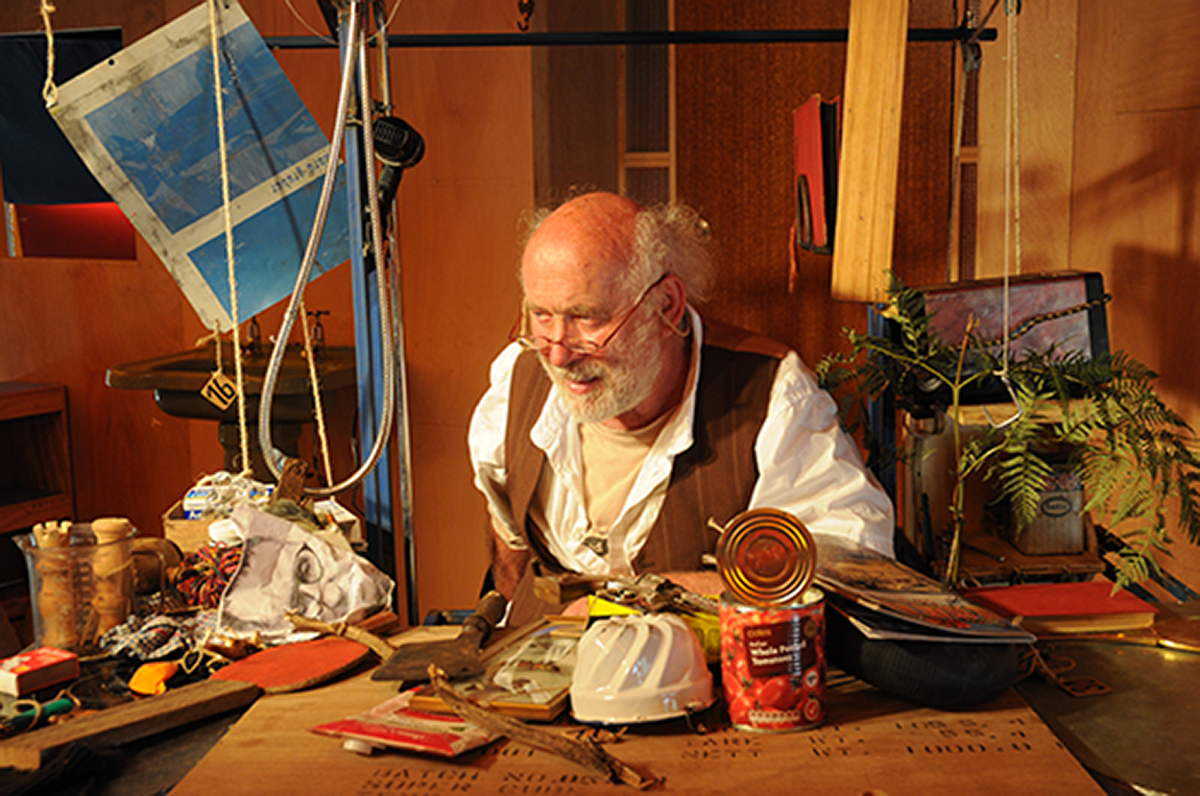
Justus Neumann, Alzheimer Symphony, photo courtesy the artist
But as the piece progresses, and such mnemonics fail, we are left with the enactment of a concrete poem of spatula, eggs, balloons, photographs and the wrinkles of Neumann’s face, shifting and re-forming like seismographs of a life still worth living. These, however, constitute an alternate, and alternative, virtuosity.
Threshold 2 (soporifics):
Trevor Patrick in Wendy Morrow’s Sleep (2002) hangs, suspended in a space between walls (where two walls fail to meet, or have just parted). There is an illumination from behind his body – in this gap, from whence he’s come. His bony cheek rests against an edge. Is this the beginning, or the end, of his life? Is this — the in-between (sifting, sorting, re-conditioning our worlds) — the more real (world), that needs our attention?
Amongst all my comings, doings, namings, is this piece (of dust, to which we all return) the most important one?
Threshold 3 (a very particular dream):
In London with RealTime for LIFT (London International Festival of Theatre), 1997. In Queen Elizabeth Hall for Saburo Teshigawara’s I was Real-Documents. Dusk. A terrace, a dusk that crawls. The parterre moves; furry figures rearrange themselves. Night birds crackle; wings stutter. A trumpet sounds a modal corridor. Four men enter, soundlessly, bend down to pick up soft sailor hats. They wear them, remove them, exit silently. They are hardly here, have hardly been. One; two; three more. One; then three more. Night slides further in.
This bending (to retrieve, then disappear) becomes a motif: to enter and to bend is an honouring. They are supplicant: remembering a meaning. Pate vulnerable, neck low, laid bare to the axe-man. To whom is this sacrifice laid bare.
And I am here. Where are we, collectively. Is this, or not, my own dreaming.
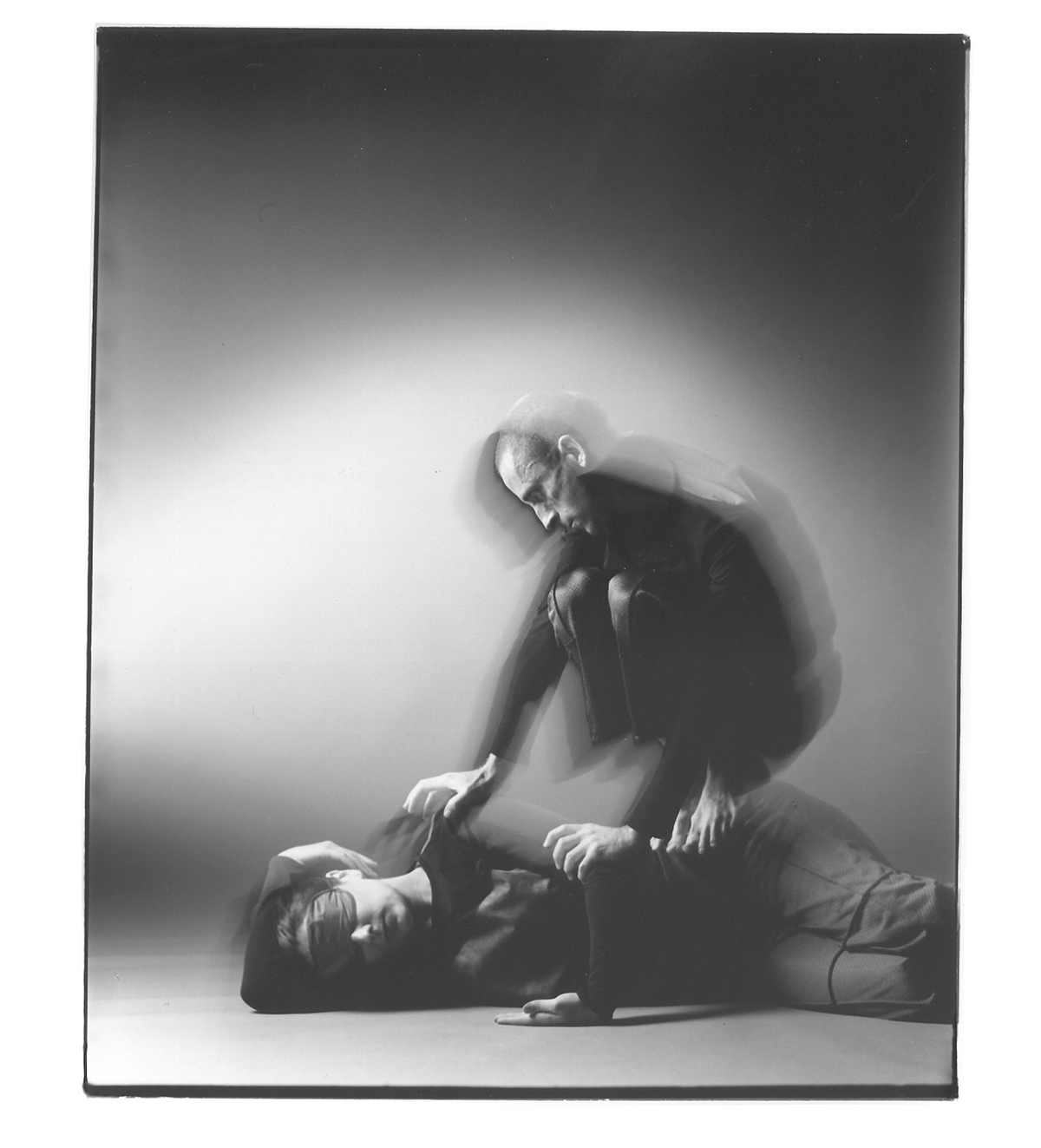
Rebecca Hilton, Trevor Patrick in Lucy Guerin’s Heavy, photo Ross Bird
Threshold 4 (measurement):
Lucy Guerin’s Heavy (1998) challenges me differently, with bodies slipping, dissolving and then jerking half-awake, juxtaposed against the steady constant of an EEG print-out falling from the ceiling. The printout, a long and continuous cascade, is science-as-waterfall: inexorable, as is science in contemporary consciousness, asserting its measures upon us.
In the review Philipa Rothfield and I discuss the difference between representations of sleep from inside-out, or outside-in. Like a tempestuous goat, I assert: “This is not how I dream,” insisting that a dream’s slipstream can never be measured via a polygraph machine. I write:
“Touch me with silk, I will chant you my palaces. Dip me in quicksilver, I will chart you my night escapades. Knights and dreams and flossy places. I know exactly where I don’t know where I am.”
We are “the stuffings of sleep”, I say, “Shakespeare’s pillowslips.” Oh, if only — as, in years since, I have followed my two children into worlds where the black seams of sleep provide not such comforts as this. My soft poetic polluted dreams.
But, at the time of watching Heavy (cocksure) I write: “you forget the science of it, the opening night crowd of it; you see patterns (e)merge, patterns of patterns, pairings, shiftings, allegiances that betray you, or stay loyal. They are our sanity, these re-patternings, as limbs stretch and reclimb the vine and beanstalk that’s been commanded to regrow.’
At the time of viewing, “the edge of my tongue itches at a fairy-tale. A Luna Park smile appears in sinister bones.” It is now 20 years, and two children, since I wrote this piece. Do I still believe the same?
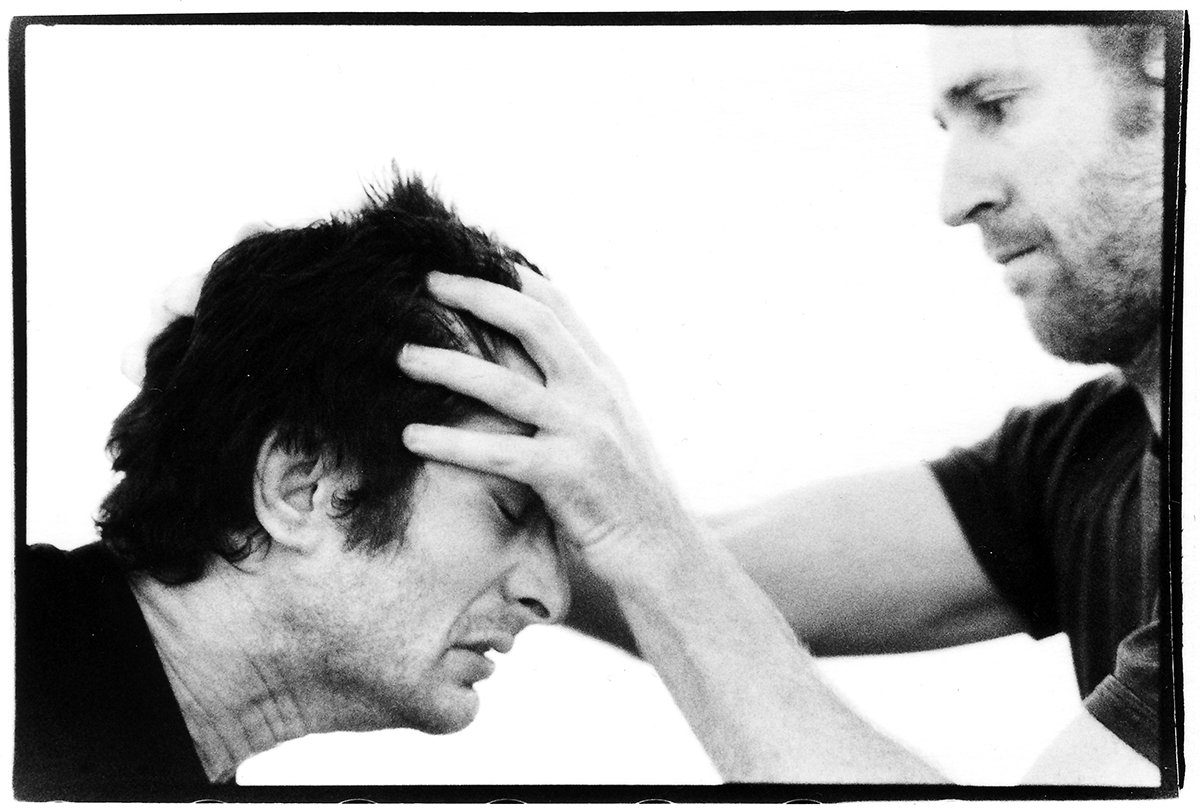
David Corbet, Jacob Lehrer, Excavate, photo by George Kyriacou courtesy Australian Choreographic Centre
Threshold 3 (digging):
During Excavate (2006) — an examination of Australian masculinity — David Corbet climbs up Jacob Lehrer’s body as if it were a mountain, or an elephant. High-seated as a rajah, Corbet blinds Lehrer with his hands, steers his face. Lehrer also self-directs, propelling the double-bodied monster into the audience. This is both filmic hyperbole, and real-time fright. An arch combination of (pro)positions.
There’s plenty of ‘men’s business’: jamming fists, noir back-alley brawls, bam, smash, pow. But what troubles me is not this overt violence [faked, though it is].
But where do these men’s hands go and not go? What and how do they not touch? What is more violent than completing a violent action? What multitude of qualities, dialogues and choices is in those hands before they smash the other player into the wall?
In a post-show forum, Lehrer dismisses (but Corbet is fascinated by) the challenge posed in these questions. So many in the audience later tell me they are so very glad I asked. It seems that near-violence touches us, so many, I had not realised quite how many. The forum’s audience seems relieved to have the questions opened, if left unanswered. Our troubled speculations go out with us, into the night.
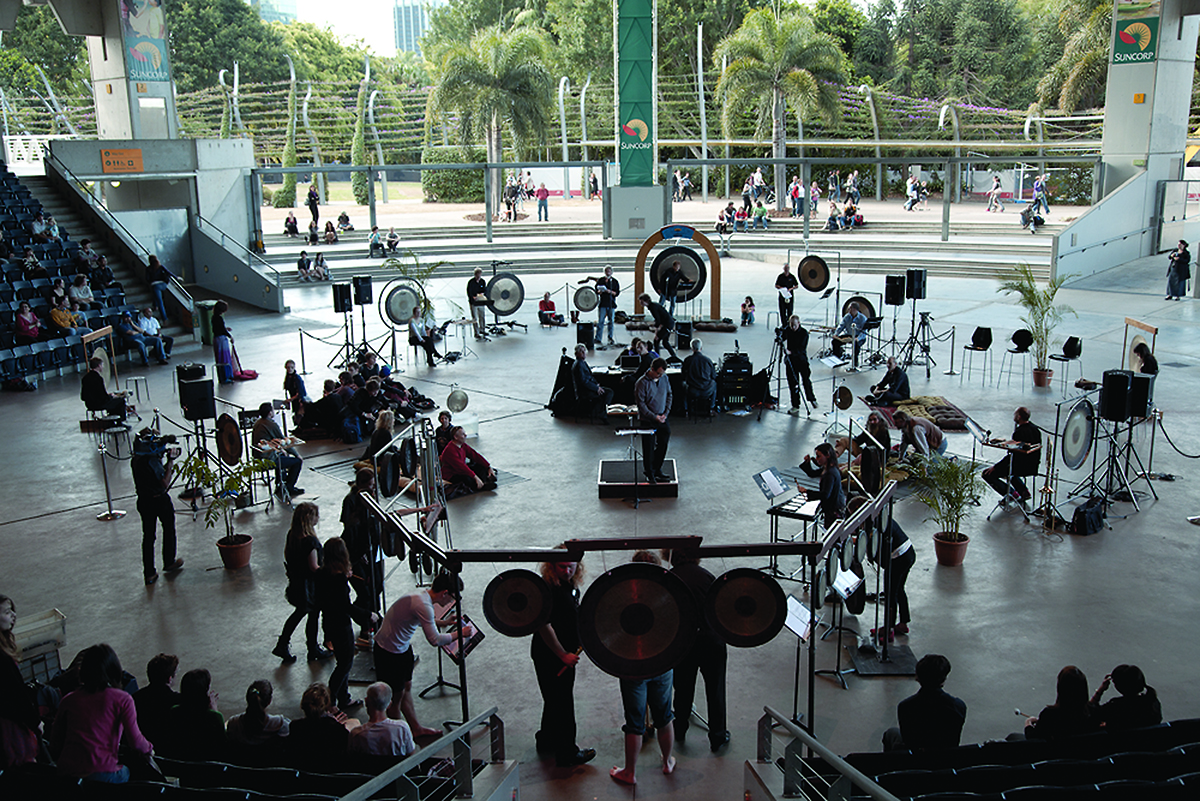
Australian Percussion Gathering, Brisbane, 2010
Threshold 4 (silences):
Percussion performance of course requires the touch of skin, or mallet, against membrane. As does caressing, child-rearing, boxing and punch-outs.
In 2004, I witness Steve Schick perform Iannis Xenakis’ solo Psappha as if he were strung and pulled with high-tension wires. In 2010, he performs the same piece, in what he estimates is his 250th iteration. The piece still holds a violence; he kicks the side drum like a tempestuous goat, obsessive, seething. His master class at the first Australian Percussion Gathering, Brisbane, 2010 shared techniques with students, on how to help keep oneself fresh and able to surprise oneself in performance.
Schick emphasised percussion’s humble, tribal origins: the contact of skin-to-skin, hand to drum membrane, our bodies as membranes and mediators of the world. He even quietly threw the challenge to younger students to consider the shamanic origins of performance, a player perhaps passing through membranes to other or hidden worlds. This provocation matched the tone of the conference as a whole, which was remarkably uncompetitive and non-aggressive — in part, in honour of Australia’s earliest percussion mentor, Barry Quinn, who would apparently teach anyone who could throw a stick at a wall and catch it on the rebound.
But as Artaud wrote, “Being has teeth,’ and “Being” can be both encouraging and fierce. There was nothing quite like witnessing Sylvio Gualda (for whom Xenakis wrote his exacting percussion solos) demonstrate “not ffff [quadruple forte] but energy” with barely a flick of his wrists. It was like the Concorde’s sonic boom at 10 paces within two seconds (moments Corbet and Lehrer, for example, did not understand). Gualda holds this split-second ignition in his ribs. Boom Crash Kapow.
However, other acts of percussion do other things in term of bodies in place/space and membrane, potentially enacting a dialogue between our bodily fluids and the rivers, our bones and the soil formed over our lifetimes and beyond.
In a day of listening and playing in the forests of the Sunshine Coast hinterland,
“A young woman suddenly starts walking on all fours, boots on her hands (becoming animal); a senior percussionist rustles a tree (becoming mantis); two young men rumble a dying branch to its sonic death. Drums become insects and call to invisible partners across the mountainside. A song is improvised beside a Bunyip’s waterhole. Jan Baker-Finch rustles her body like leaves, moving, being moved by the winds of other improvisers.”
Threshold 5 (fireworks):
And finally there’s another side, to the impact of performing, making, being seen. Boom Crash Kapow. 1997 London International Theatre Festival: Christophe Bertonneau’s Beautiful Violence: Un Peu Plus de Lumiere (a little more light) in Battersea Park. I write for RealTime:
“Every time I see fireworks, I remember Guy Fawkes, who tried to blow up British Parliament in 1605… I have a suspicion of spectacles. All the marshalling of forces and finances, titillating toy wars removed from the battlefields. Guy Fawkes was a thug, an extremist, a separatist, celebrated annually in a fizz and pop night with various safeguards (in Australia now, illegal in one’s own backyard).
“At LIFT’s fireworks, torches spiralled in the sky. We are in Vietnam with napalm, London with firebombs. Is it the shape of the burning dragon that appeases us? The ground-level ritual most of us couldn’t see, an attempt to change meaning/appease us with paper baubles? Am I just a killjoy?
“No, of course, I too gawped and craned and wondered how much further they could go, how much higher, brighter, more audaciously changing night to day (as do poets and lovers, more frequently, cheaply, intimately), but this is awful and aweful, the crowd impatient with the in-betweens and jeering and leering and panting for the explosions once more. Our public hangings now going off with a bang.
“We are cruel masters and cruel livers; we beat dogs and wives. Fireworks express and contain our violence, colouring in hues that make the skies incarnadine or dappled green or white like stars that couldn’t possibly cluster as closely, brightly. It is very strange to be here.”
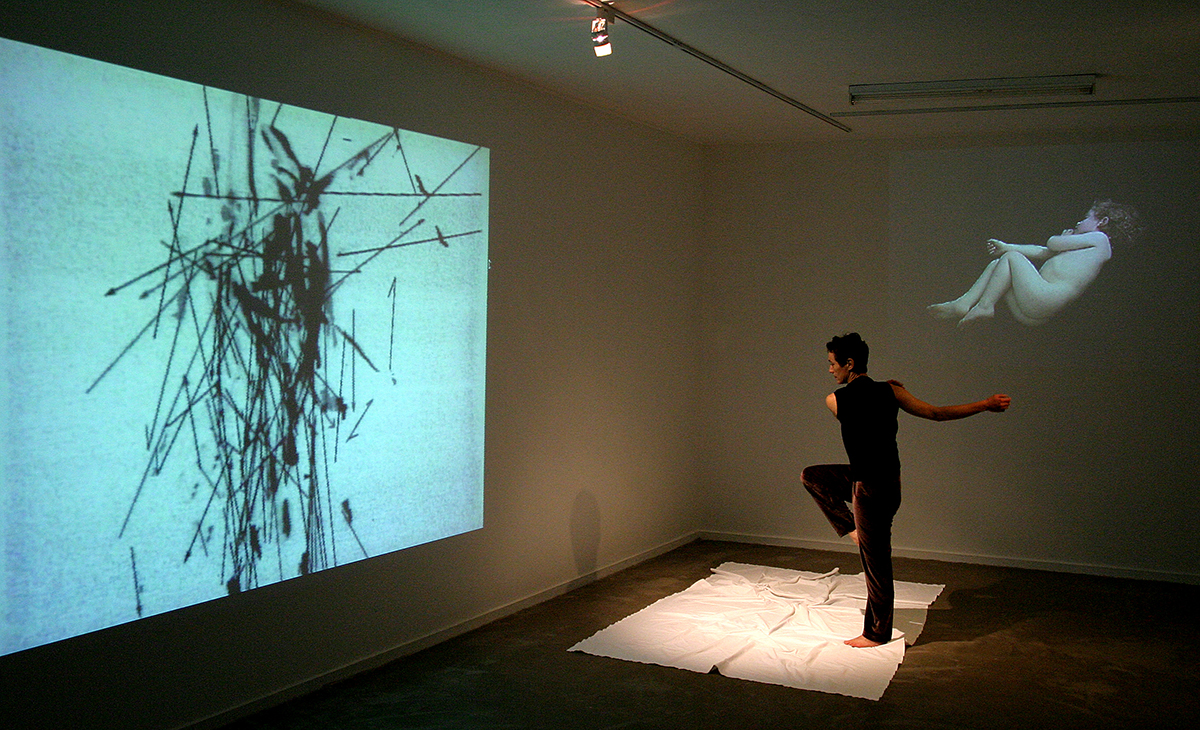
Wendy Morrow, Blue, photo Pling
Threshold 6 (futurism, and fear):
Finally, a piece that (quietly, soft-violently) talks to some of the greatest vulnerabilities in our time. In the hall of the Canberra Contemporary Arts Space, Manuka, 2004: Wendy Morrow and Leigh Hobba recreate Blue, a piece that premiered near the first anniversary of 9/11.
On screen one: a still-frame of a naked toddler with curly hair (Hobba’s son), lying asleep on his side. His hair is a halo almost larger than the rest of him. Slowly, we perceive his small wrist flicker, breath fluttering his bones.
On screen two: a streaming jet, slowed to quarter-time and travelling left to right, disappearing before reaching the edge of the screen. Repeated: travelling; a quiet implosion. The tension this creates — the long journey, the disappearance before impact renders the image a rehearsal for a fate we now know (post 9/11), and of what we then, in this piece’s first showing, anticipated as the about-to-become, the always-capable-of-happening.
We are always already capable of this: violent, violating of the inviolable. Morrow’s body knows all this; her breath holds against it (even in its release): knowing, storing and re-creating the fears and the horrors, the memories and the capabilities of attack.
Her dance represents the movements of a mother in history, mutely rehearsing a defence. It evolves from somewhere beneath the brickwork of the body’s structure — softly, fiercely, yet also, we suspect, is capable of knocking down a mountain.
A pixelated image depicts a line of national flags waving in a night sky. It is a horrible sight. So self-certain. To paraphrase TS Eliot, post-World War 1, so “unreal.”
Morrow’s partnership with Leigh Hobba has produced a subtle, complex, startling piece, full of the yearning for protection and sanctity that any parent knows, and that anyone in the West post-9/11 world has come to understand, was always fragile.
Mea culpa, mea culpa, mea maxima culpa
In the end of all these performances, is my beginning…
–
Top image credit: Trevor Patrick, Wendy Morrow, Sleep, photo courtesy the artists
Horror was my entrée into writing for RealTime. In fact, an interest in the horror genre opened the door for me to write film criticism in general. In 2010, seeking a change in direction from the customer service work I was doing to support my painting, I sent my CV around to various Australian arts publications with a request to be considered for proofreading positions. In my submission to independent film magazine Filmink, I added as an afterthought, “And if you ever need a horror reviewer…”
Filmink wasn’t hiring proofreaders, but the editor Erin Free wrote saying actually he could use a horror DVD reviewer — much to my amazement (it still gives me an imposterish frisson). RealTime in turn invited me to join its bi-monthly production days as a proofreader. Jumping forward a year or so, I was well into my side-career reviewing innumerable indie zombie and found-footage DVDs (as well as the occasional theatrical release) for Filmink, when RealTime’s designer and online producer, Gail Priest, generously suggested to the editors I might write every so often about my pet subject for RealTime.
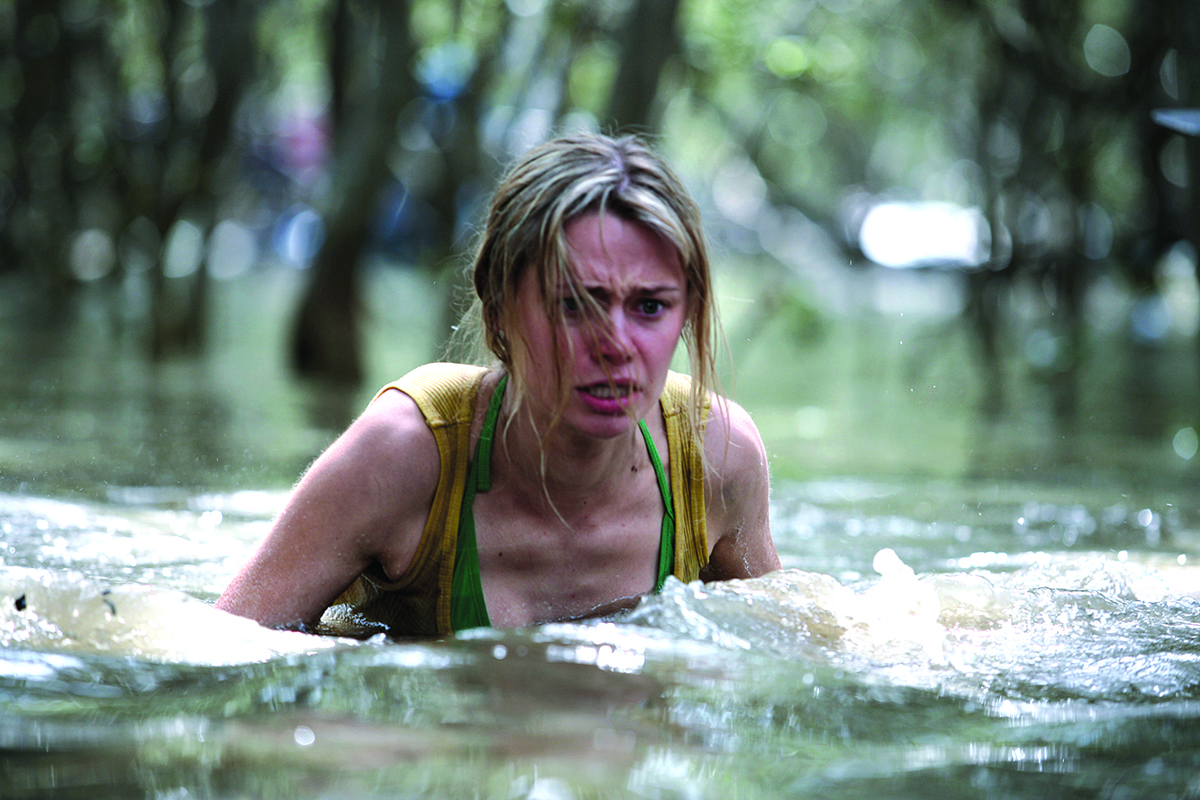
Black Water (2007)
Keith and Virginia then commissioned “The horror: how Australian?”, a substantial two-part account of the Australian horror film boom that had taken place over the first decade of the 21st century, ignited by the success of Saw (2004) and Wolf Creek (2005). The resulting article, a lot of fun to research, gave me the chance to sink my teeth into notable Australian-directed horror of the period and assess its ‘Australianness’ [Part 1; Part 2]. I watched and re-watched Saw, Wolf Creek, Andrew Traucki’s understated croc thriller Black Water (2007), Jody Dwyer’s cannibal-convict extravaganza Dying Breed (2008), the Spierig brothers’ zombie and vampire outings, and The Loved Ones (2009), Sean Byrne’s maniacal coming-of-age scenario.
If writing the same article now, I would have further probed the concept of ‘Australianness’ as it applied to each film. The two-part article is introductory and descriptive in form, an indicative but by no means exhaustive guide to the main players of the decade in question; but it was a solid beginning for me in considering the impact of socio-cultural conditions, identity and market forces upon cinema, especially in the context of a genre that had been dismissed, until very recently, by Australian film funding bodies.
So why my fascination with the horror genre? From a critical perspective, I love horror because it is such a fertile field, supplying endlessly varied material to think and write about. Fear is a shapeshifter, assuming numerous monstrous forms according to the traditions and cultures in which in arises, mirroring societal anxieties. I love analysing the cinematic language different filmmakers use to convey horror; to create that very particular sharpening of the senses conducive to dread, visceral repulsion or stark beauty (the awe-inspiring sublime). On a deeper, more personal level, horror draws me with its promise of a darkness rarely glimpsed; a hint of the Mysteries. My definition of horror is broad; probably too broad to be strictly accurate, though I consider the opposite opinion, that horror is inherently crude and vacuous, to be just as inaccurate. Horror is a mood, a physical feeling that transcends genre parameters.
The works appraised in The horror: how Australian? all fall uncontroversially into the horror bucket (though The Loved Ones messes with the feminine ‘princess’ narrative with insight and wit), but I’m alert for elements of horror in all sorts of films. In fact, while I still appreciate a straightforward horror flick, I’m increasingly drawn to films that take an experimental, lateral approach to horror, something that dovetailed with RealTime’s focus on risk-taking and innovation. Enter a singular horror film festival that embraces this kind of cinematic ambiguity. A revelatory experience of my RealTime years has been covering the remarkable Stranger With My Face International Film Festival in 2014, 2016 and 2017. Founded in 2012 by Hobart-based filmmakers Briony Kidd and Rebecca Thomson, the festival showcases women working in the highly male-dominated domain of horror and dark genre filmmaking; this in a field where women are already grossly underrepresented. (Note that none of the directors in my “The horror: how Australian?” is a woman.)
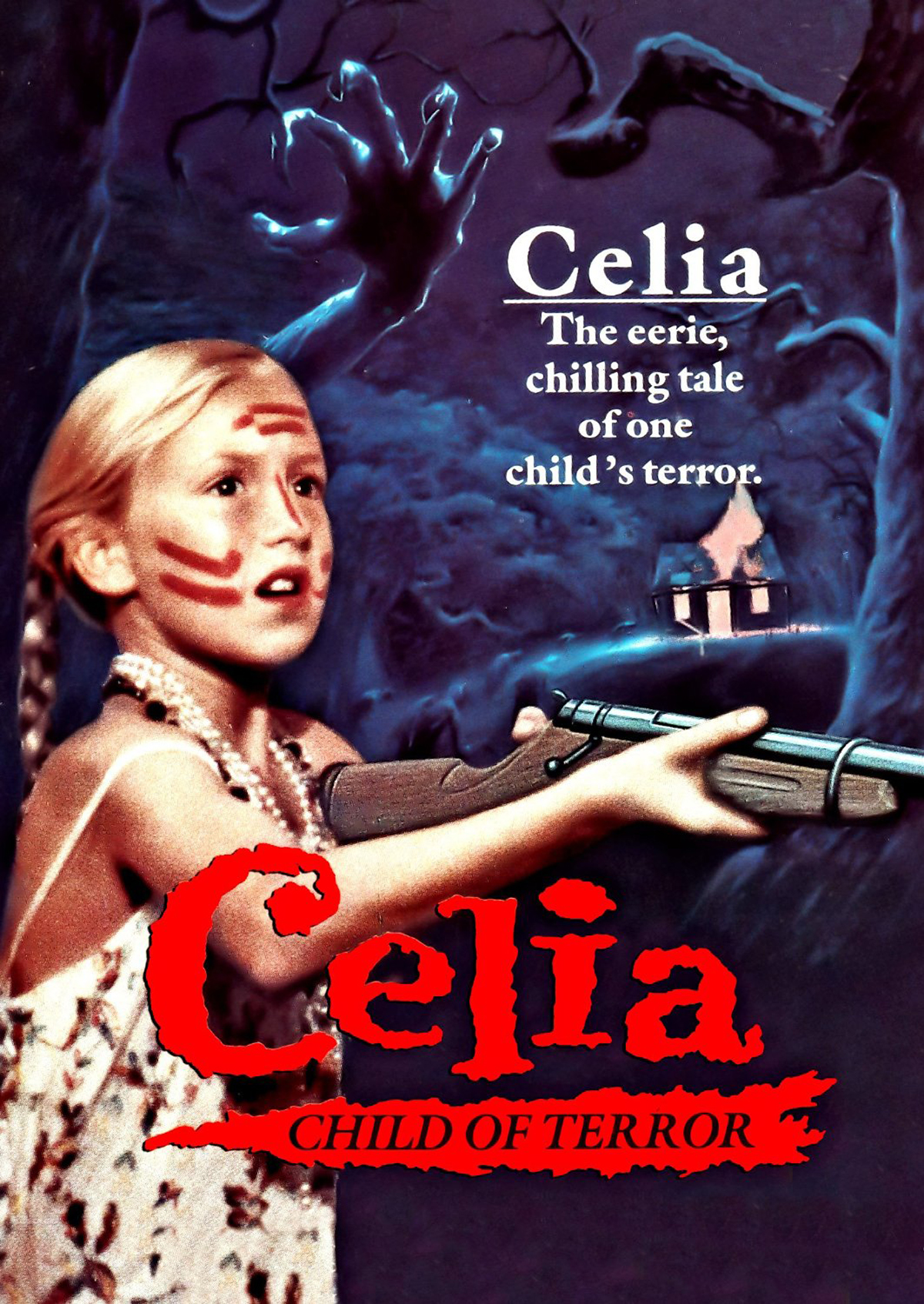
Promotional poster for Celia (1989)
Taking place at Salamanca Arts Centre in wintry Hobart’s historic quarter (fully living up to its Tasmanian Gothic promise), each festival ran for about four days, plunging participants into a stimulating miscellany of films, talks, play-readings and informal chat where horror was the order of the day: horror you weren’t used to seeing; horror that sprang from women’s experiences and perspectives; horror that forced you to reassess your assumptions of what it was; horror reconstituted, reappraised. It was a forum for recognising seminal works from past decades by writer-directors like Gaylene Preston (Mr Wrong, Perfect Strangers) and Ann Turner, and hearing them talk about their experiences as female filmmakers. Of Turner’s Celia (1988), I wrote:
“Celia is a remarkable evocation of an Australian childhood whose terrors, enmities and fantasies transform, in response to 1950s political paranoia, into something jagged and dangerous…Chris Neal’s chiming score contributes strongly to the sense of an eerie childhood underworld. The film’s detours into fantastic surrealism, gradually dovetailing with moments of real-world violence, led Kidd in her introduction to name Celia as a precursor to Peter Jackson’s Heavenly Creatures (1994).”
The subject of violence against women — a horror mainstay — was turned inside out in feature films Evangeline (Karen Lam, 2013) and Kept (Maki Mizui, 2014):
“It is hard not to be reminded, while watching Kept and Evangeline, how completely they upend conventional crime/horror narratives where an unformed female character is raped or murdered purely to drive the plot and further the character development of an often male protagonist and his antagonist. In Lam and Mizui’s scenarios, the viewer must remain with the victim; there is no escape from the suffering she endures, nor its consequences.”
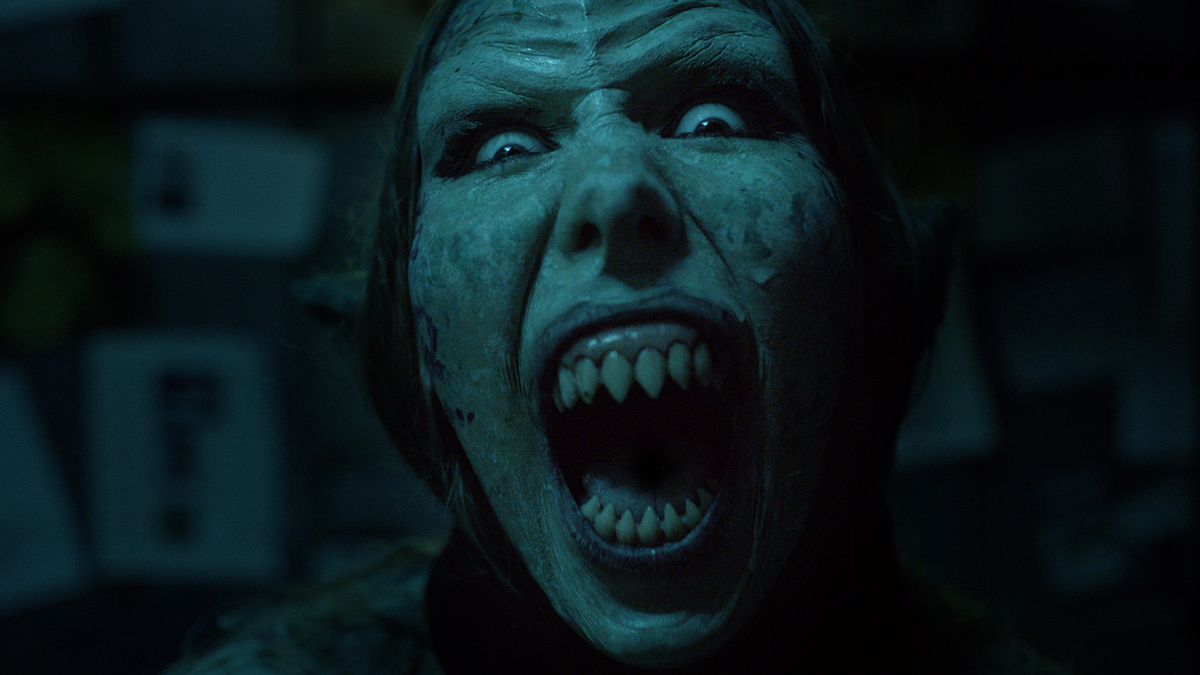
The Man Who Caught a Mermaid (2017)
SWMF introduced me to the quietly ominous films of Mattie Do, Laos’ first female director and maker of its first horror film, who spoke of “the pressures and pitfalls of making a horror film in Laos…”; Lucile Hadzihalilovic (Evolution, 2015, France); Anna Biller (The Love Witch, 2016, US); newcomer Elizabeth E Schuch (The Book of Birdie, 2017, UK); and Australians Donna McRae, Katrina Irawati Graham and Megan Riakos. Films in the 2017 festival shorts program made powerful political statements, including Luci Schroder’s grimly realistic Slapper (2017, Australia), Kaitlin Tinker’s unsettling modern fable, The Man Who Caught a Mermaid (Australia, 2017) and Kristy Guevara-Flanagan’s What Happened to Her? (USA, 2016), “a startling assemblage of film and TV clips demonstrating the sheer proliferation of nubile female dead bodies on our screens.”
Stranger With My Face further demonstrated to me the potential of the genre. As Briony Kidd said when I interviewed her for the 2014 festival, “I’m looking for films that have something to say. There’s an assumption that genre is mainly escapism but, to me, there’s so much scope in horror to be provocative or extreme or personal or original, so why wouldn’t you take advantage of that?”
Horror indeed gives filmmakers leeway to tussle with complex themes in a heightened, symbolic way. Before The Babadook (2014) attained international cult status, I interviewed the film’s director Jennifer Kent in some depth about the themes underlying this folkloric tale of a storybook monster tormenting a mother and child. Kent explained:
“Motherhood is a big taboo, isn’t it? It’s a thing we can’t really discuss in regards to not being good at it, or not wanting to do it sometimes, or not liking your child, sometimes even wanting to kill your child on certain days…that’s why I wanted to put it into the horror genre and not just a drama, and to take it further, and it’s worked in that it helps some women connect to it.”
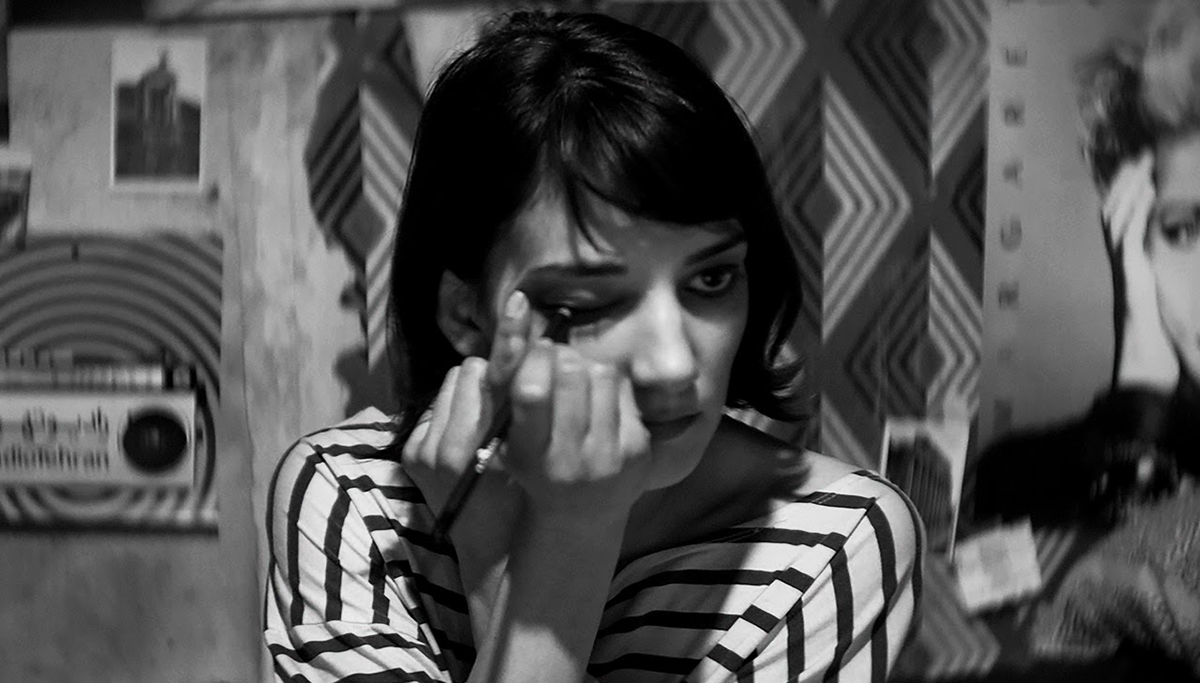
A Girl Walks Home Alone at Night (2014)
Some horror struck me with its sheer beauty. Watching Ana Lily Amirpour’s debut film A Girl Walks Home Alone at Night (2014) is to enter a “shadow world” that “floats in time as well as geographically,” through which characters move with silent-film intensity and the languid grace of dancers, the locus of fear pinpointed in the small, chadored, mesmeric person of the titular Girl. In It Follows (2014), “the viewer is enclosed in a big, sublime world encompassing unfathomable terrors,” pushed into an awed state of hypervigilance through the repeated use of exquisite figure-in-landscape longshots, crystalline close-ups of nature and 360-degree rotating shots, combined with Disasterpeace’s shimmering soundtrack.
Looking back on the past decade or so of reviewing, I appreciate the way Filmink taught me the knack of the short, rapid-fire review, with an eye to — sometimes jokily — assessing the film for fellow horror buffs. With RealTime, I could get expansive; slow down and contemplate the nuances and ambiguities. I had moved from a critical position of sitting outside the space of the film, to fully immersing myself and reporting back from within. I think I brought similar convictions to both publications — I’ve always had scant tolerance for the lazy deployment of violence against women, for example, but the years at RealTime increasingly opened my eyes to the depth and variety of women’s independent horror (and conversely to the ways in which standard horror falls short); I saw that horror can be done differently.
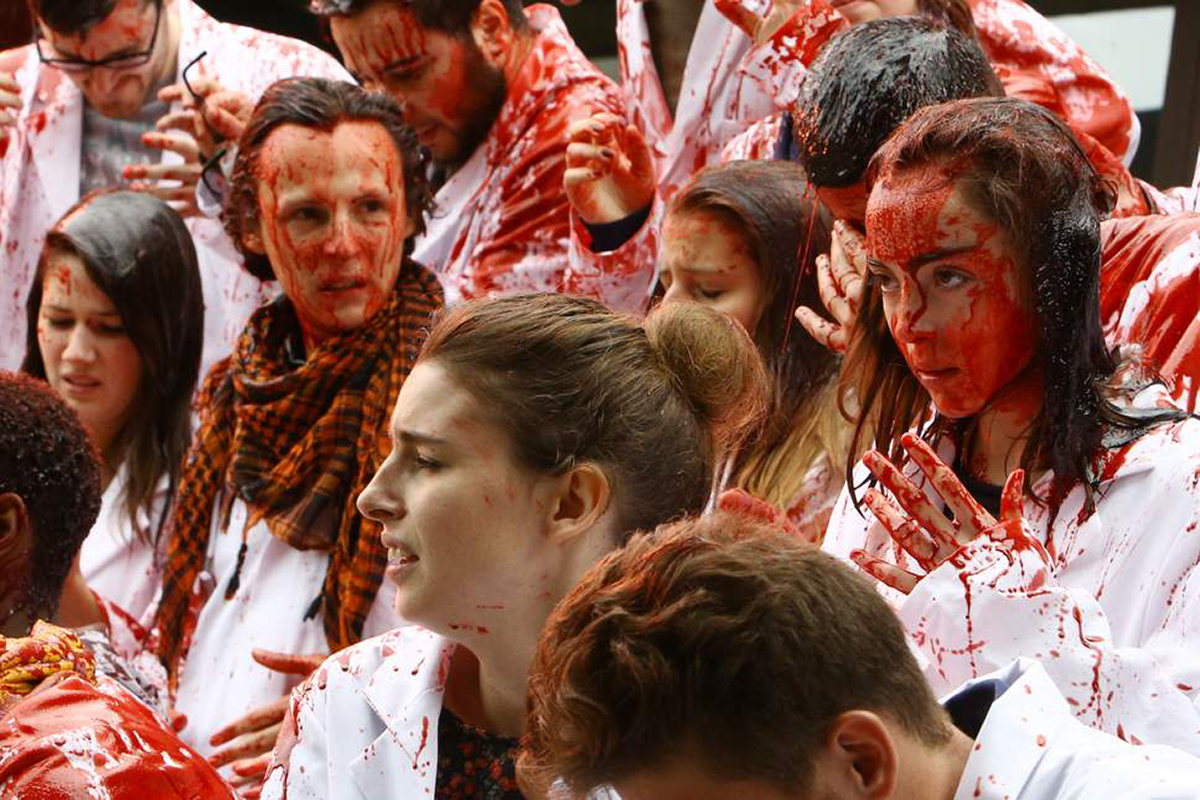
Raw (2016)
I had the luxury of focusing my reviewing choices on striking works by women directors, like The Babadook and A Girl Walks Home, as well as Julia Ducournau’s Raw (2016) and Alice Lowe’s Prevenge (2016). I could follow the career of Australia’s definitive horror director Greg Maclean from Wolf Creek 1 and 2 to the survival thriller Jungle. And I could dwell in the dark ambiguity of less easily categorised films like Under the Skin (2013) and Personal Shopper (2016).
RealTime’s encouragement of writer individuality is evident in the way the editors have indulged and fostered this niche interest of mine with characteristic humour, perspicacity and an openness to the possibility that this type of cinema might be “serious horror indeed: multilayered, rich and strange.”
–
Top image credit: The Babadook (2014)
If memory serves me correctly, it was Alessio Cavallaro [co-editor with Annemarie Jonson of the OnScreen supplement] who approached me to write something for RealTime on soundtracks. I had known Alessio since the early 80s through his key involvement in Sydney currents of experimental music through his 2MBS-FM radio show, releases and events. He effectively brokered my entry into RealTime, and I was warmly welcomed by Keith Gallasch and Virginia Baxter.
At that early stage, RealTime – in my view — was not something I would have considered for two reasons. One, it was very strong on its coverage and writing on the live performative arts; and two, its adoption of a transformed Filmnews in the guise of its OnScreen section. Throughout the 80s, my critical interests in cinema and music had led me to find various niches, nooks and crannies for publishing articles, running a synchronous though far less rigorous line engineered by my colleague Adrian Martin. While Adrian occasionally published sharp and incisive critical pieces in Filmnews, I had mostly found that newspaper’s writing socio-politically oriented, and somewhat defensive and divisive in its support of Australian independent filmmaking.
My view then (as now) was that the cultural binaries which hold ‘independent’ and ‘mainstream’ in place forge segregational liabilities in fostering a deeper understanding of the complex ambiguities, contradictions and simultaneities which make film culture a fascinating mess. Having had no connection with the 70s counter-cultural avenues which created and nurtured ‘Australian independent filmmaking’ (the film co-ops, government lobbying, distribution networks, etc), I shared few of its values or ideals – which were intoned through much of what I regarded as an anti-intellectual bias in Filmnews. Maybe it worked well for originating filmmakers with those values and ideals, with Filmnews operating as a galvanising newspaper for a community of like-minded artists, but it simply wasn’t for me. When I made Salt Saliva Sperm & Sweat in 1988, the film inevitably flowed through the paper’s channels and was critiqued not as something different and alternative, but as something wrong and unwarranted. All I did was make a film which demonstrated one of a million ways in which one could produce ‘Australian independent filmmaking.’ Its reception in those quarters reinforced my views of that context: when writing pays lip-service to ideology rather than the cultural object at hand, the velocity of ideas withers.
Sooooo, when Filmnews transitioned into the RealTime’s OnScreen, I would have to admit that while comprehending the importance of creating a communal/industry organ for independent filmmaking was important for its practitioners, I still found the critical writing lacking in breadth, flexibility and case-by-case evaluations which could augur a rethink of ideological mandates on ‘Australian independent filmmaking.’ Counter to my prejudices, broader and tangential currents of film cultural discourse gradually seeped into OnScreen, and in this softening of didacticism I assume Alessio saw the opportunity for it to encompass what by the 90s had become numerous tentacles of media intervention, artistic reformulation and critical practices to do with ‘the moving image.’ With a strong background in audio arts, Alessio tagged me as someone to bring some noise to the proceedings.
Film as experienced, in the cinema
Superficially, the articles for Cinesonics were directed toward surround-sound production done for feature films, evaluated as experienced in cinemas. But the articles were also inevitably contextualised by (a) the state of this thing called cinema at that millennial point in time, and (b) how critical rigour could be applied to theorising ways in which sound/image, music/narrative, psychoacoustics/character and other audio-visual compounds were being developed in current films of all stripes. Like unpacking a matryoshka doll, there was always something else rattling inside any element I analysed. Sitting in the auditorium, I would be excited by some sonic or aural moment in the film, but when I returned that night to write the article, I found I would have to laboriously contextualise why that moment was noteworthy.
A shattering crash in The Haunting (RT33); a drone of nothingness in Lost Highway (RT19); Eddie Murphy interacting with composited/post-dubbed stand-up lines in Doctor Doolittle (RT26); the absence of music and the roar of air-conditioning in Contact (RT24); New Orleans Gothic swamp funk in Michael Jackson’s GHOSTS (RT20); the aural hormonal bombast of teen energy in Bring It On (RT41). Each of these moments — lived in the present while auditing the films — was like a lock to comprehending the what, how and why of the film soundtrack’s greater potential. But each sentence I wrote was snared by assumptions that I was somehow addressing notions of ‘the film industry,’ ‘quality movie-making,’ ‘professional craftsmanship,’ ‘technical standards in mixing,’ ‘good film music’ and so on. In attempting to address cinema at its most experiential moment of occurrence, I was confronted with the overwhelming thrill of matching my chosen film analysis with how cinema was forming itself then and there. The Cinesonics articles were exploded diagrams of these theoretical matryoshka dolls — and their wooden box, the bubble wrap, the cardboard package, and the way it had all been damaged in transit.

Neon Genesis Evangelion
When I took leave of writing the column after 21 articles, I remember Keith Gallasch joking he would miss having to watch all the awful movies I wrote about. True, I wrote a lot about awful movies — but mainly to evidence how their sound design, song selection/placement and composed film score gave momentum to the repressive and limiting measures embraced by both bland industry acolytes and prissy arthouse proselytisers. This is why I mauled the audio-visual flaccidity of Lost In Space (RT25), Armageddon (RT27), Doctor Doolittle (RT26), The Truman Show (RT28), Virgin Suicides (RT39) and Run Lola Run (RT32). For the same reason, I pored over the sono-musical complexity of Lost Highway (RT19), Contact (RT24), Neon Genesis Evangelion (RT31), Magnolia (RT 36 and RT 37), I Stand Alone (RT32), The Straight Story (RT38), Bring It On (RT41), Cast Away (RT42) and Crazy (RT43).
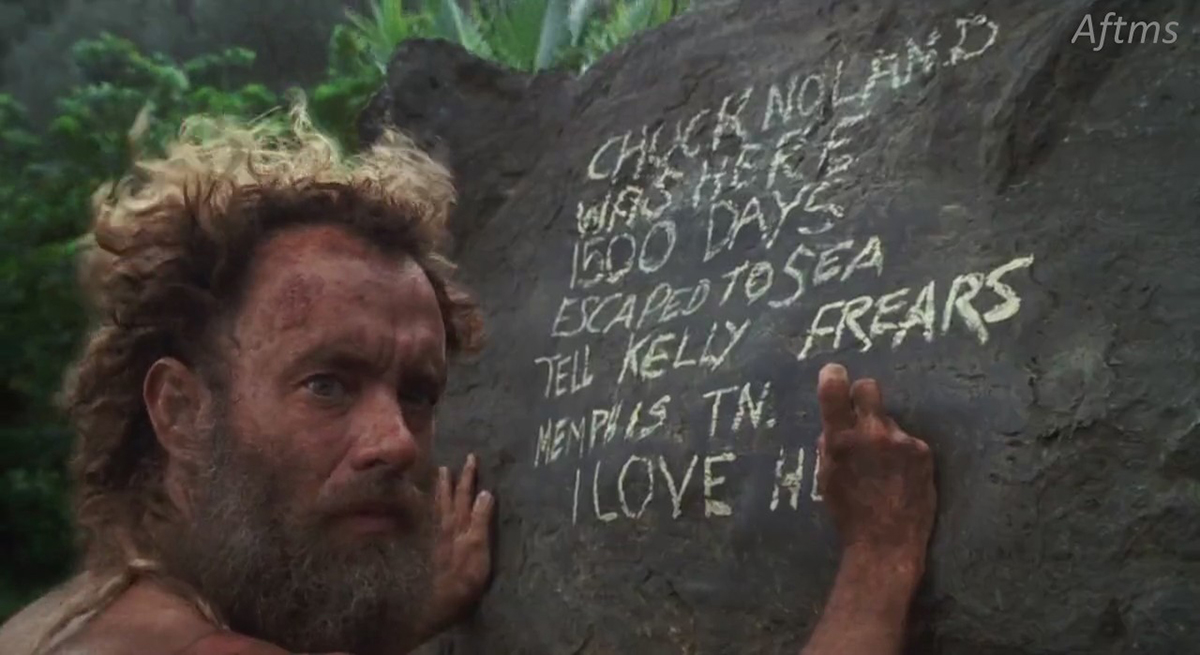
Tom Hanks, Cast Away (2000)
Indeed, a running thread through the articles traces an aversion to condescending humanist proclamation, bordered by an attraction to post-humanist sonority and musicality. The more a movie asserted its hand-wringing, globalised anguish or fluffed-up its poeticised, narcissistic moralism, the more disdain I coughed onto its whimpering candle. The more a movie moved past humancentric posturing and patronising concern for ‘the world,’ the more I fanned the flames of its meta-discourse of non-holistic characterisation, conflicted ethics, ambivalent tone and psychological displacement. Why? Because while so much of the supposedly ‘informed/committed arts’ aspire to the latter, they end up too often voguing PC altruisms against a backdrop of naive utopian wishfulness. Personally, I don’t care at all how pathetically humanist and self-centred films like Armageddon and The Truman Show are, or whether such films continue to be made. I am more concerned when half-baked ‘art’ — as in ‘arthouse cinema’ purportedly opposed to ‘Hollywood fodder’ — replicates the same sappy greeting card sensibilities.
Yeah, but even when I think about it, this approach smacks of its own moralism. Fortunately, RealTime overlooked these infractions of authorial solidity. Keith and Virginia would usually query me over a lava stream of literary vitriol and request better justification for my assertion. This was always appreciated, because the core aim of Cinesonics was to be ‘hyper material’: each and every assertion had to be qualified by an adequate description of how the soundtrack materialised the moment under scrutiny. Prior to hitting the send button for each submission, I would often open the article and randomly highlight a small section of the text: whatever I picked had to have verbs and nouns strictly associated with describing sonic and aural phenomena. (I just tried it on some of the articles. It still works.)
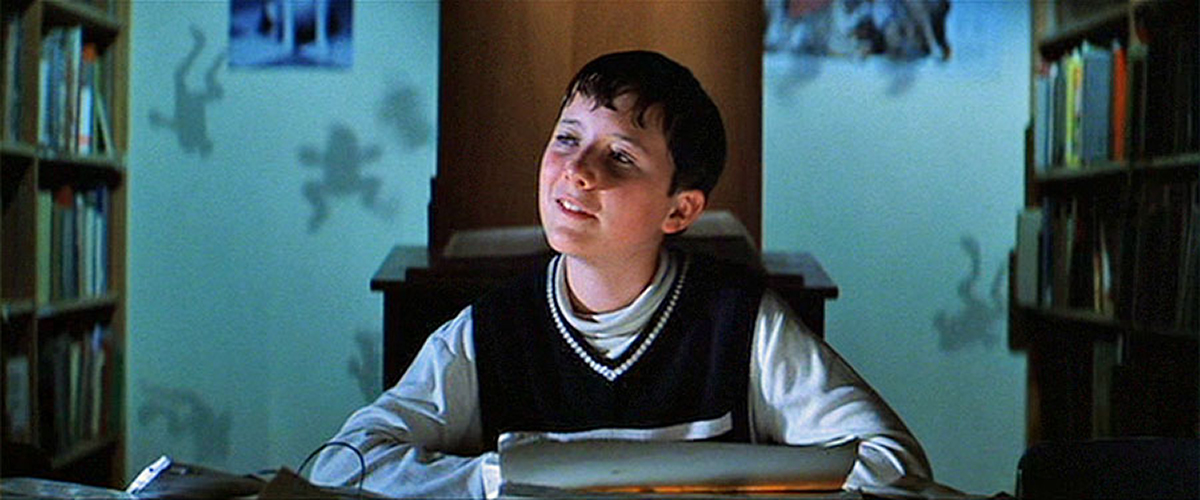
Magnolia (1999)
Real time writing
The Cinesonics articles were written usually a few hours after seeing/hearing the film in the cinema, and were drafted to capture the isolated, episodic or continual flow of the film soundtrack’s eventfulness. On reflection, it makes sense that RealTime — with its roots in the performative arts — welcomed this approach to critical ‘real time’ writing on the cinema. I can’t think of any other film-related publication — then, before or now; indie, alt, industry or mainstream — that would get what I was after with this approach. I don’t care whether the Australian film industry and the various government, departmental, officiated, privatised, gonzo, alternative, advocated, sharing or streaming tentacles of its ‘moving image culture’ wither and die. I’ll always find some speaker cable in its viscera. I’ll hook it up to a sea-soaked battery and connect it to my pelvic bone. And I’ll still find plenty of cinesonic moments to thrill me.
In some fact-checking for this reminiscence, I stumbled across this:
“The relationship between sound and image in film has always presented filmmaking with interesting effects and problems. Probably the most primary source of textual conflict (where conflict generates meaning) is the sound/image relationship: an inexhaustible dichotomy in the construction of a film text. (…) The sound and image texts feed and feed off each other. Through modes of deconstruction, these texts can be dislocated, scattering the meanings contained within them.”
That’s me, 21 years old in 1981, writing a program note for my Super 8 film The Opening Ceremony Of The 1980 Moscow Olympics As Televised By HSV Channel 7. If I thought I’d changed much over the years, it seems I really haven’t. And if you don’t share my formative values and ideals (Count Yorga Vampire, Iggy Pop’s The Idiot, Roland Barthes’ S/Z, Straub & Huillet’s Othon, Lipps Inc.’s Funky Town) then feel free to dismiss all you just read – and start something new.
–
See also “Move fast and hear things: writing Audiovision,” Philip Brophy’s reflections on writing his 2015-17 column for RealTime.
Top image credit: Patricia Arquette, Bill Pullman, Lost Highway (1997)










































